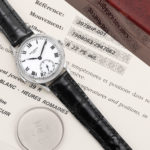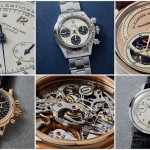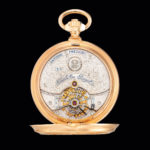Highlights: F. P. Journe at the Sotheby’s Hong Kong Auction
Lots of brass, a bit of ruthenium, and of course red gold.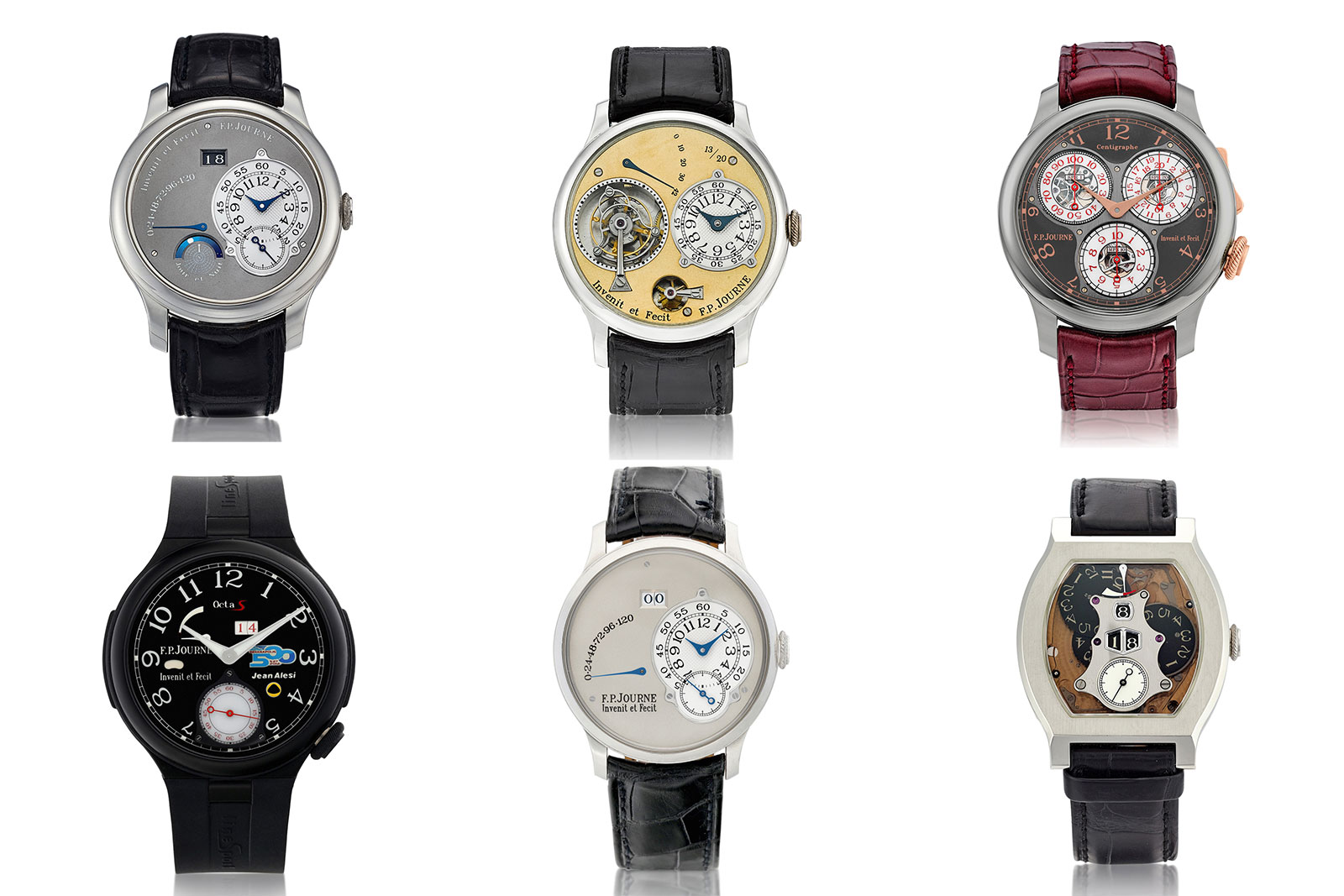
F.P. Journe has swiftly become one of the most desirable independent watch brands, resulting in an ever growing selection on offer at auction. Perhaps the biggest single offering to date comes by way of Sotheby’s, which has amassed a 13-piece lineup of F.P. Journe watches for its upcoming Important Watches sale that takes place in Hong Kong on October 13, 2021.
We round up eight of the most notable, a selection that naturally includes a Tourbillon Souverain “Souscription”, as well as several limited editions, ranging from Ruthenium to a Tokyo-boutique special.
The full catalogue and registration to bid are available on Sothebys.com.
Lot 2085: Octa Réserve de Marche with brass movement
Originally the entry-level model for the brand, the Octa Réserve de Marche is today a stealth watch of sorts since it is still a simple watch, but an unusually valuable one.
Launched in 2001, the Octa Réserve was part of the original trio of watches launched by Francois-Paul Journe, coming after the tourbillon and Resonance. Despite being the brand’s entry-level wristwatch at the time, it still boasted a proprietary movement with an impressive five-day power reserve, though the running time was originally envision was eight days, hence the “Octa” moniker. The cal. 1300 developed for the Octa Réserve would then go on to be the base movement for the entire Octa collection.
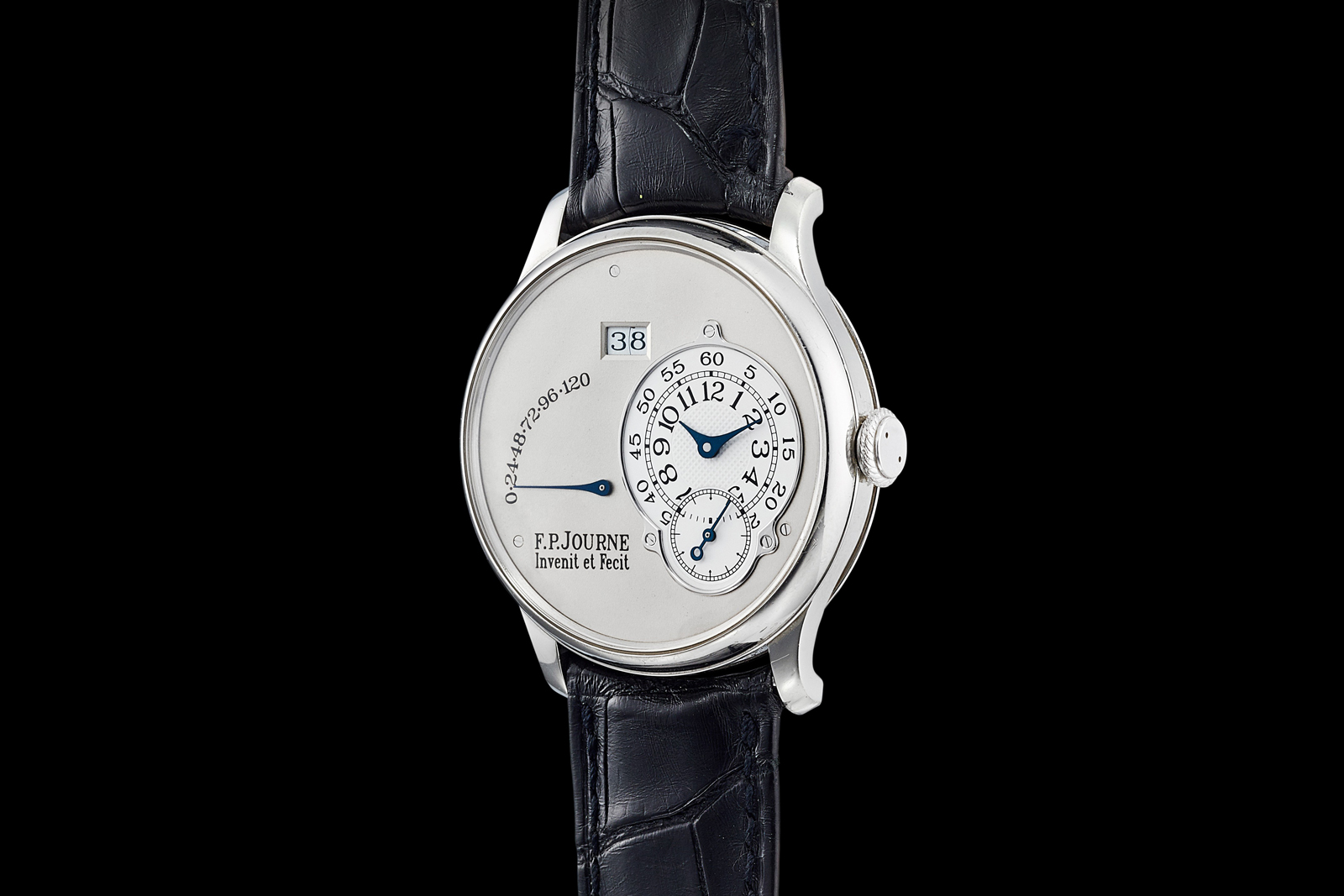
The best part of the Octa Reserve is its asymmetric dial. Showing the time, date and power reserve, the dial is more striking than the sum of its parts. The layout is vertically sectored into three columns, with the time on the right, power reserve indicator on the left, and double-digit date in the centre.
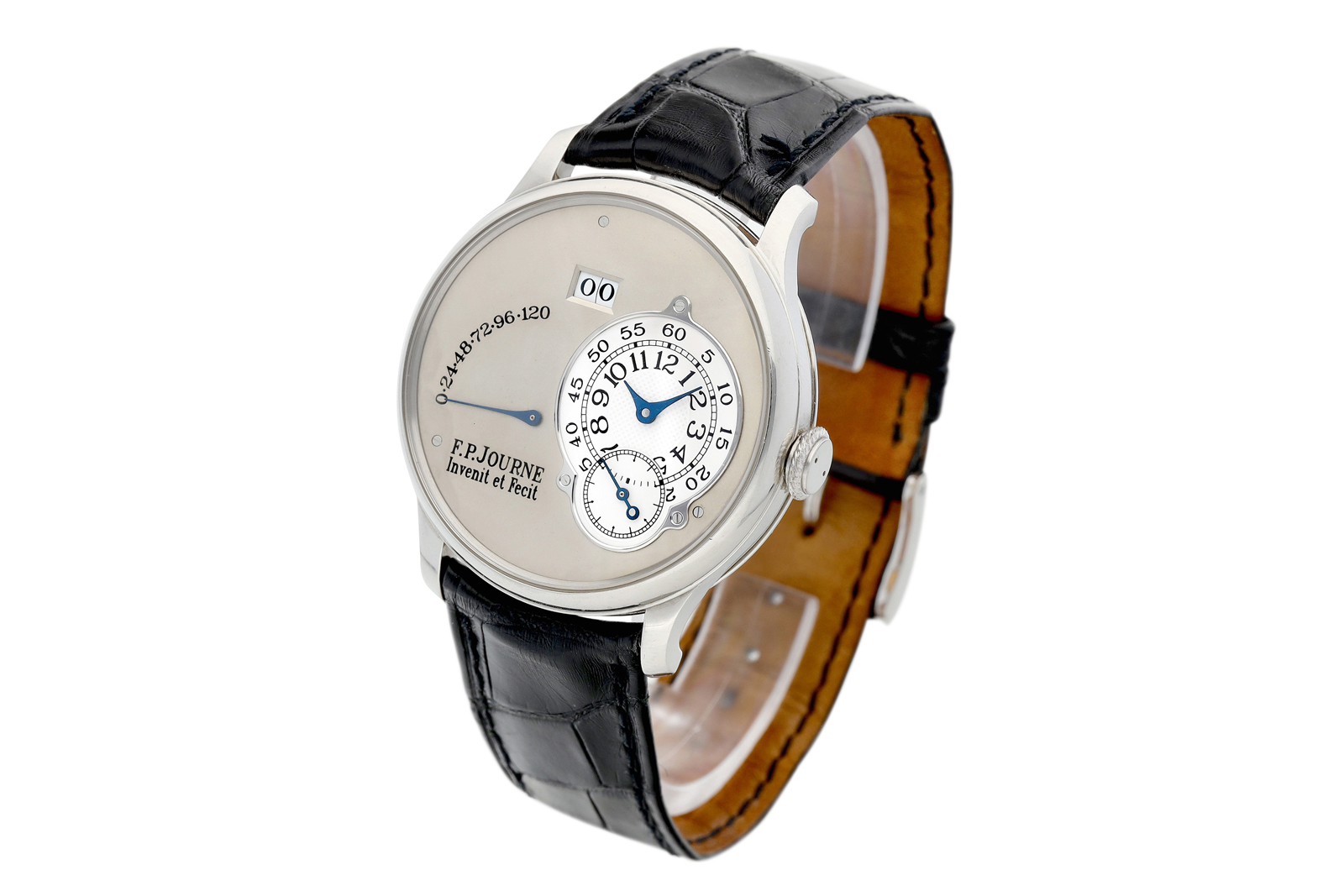
An layout that’d instantly recognisable
Circa 2002, the present example is a typical old-school Journe, which means a brass movement and 38 mm case, both no longer offered by the brand. While the brass bridges and base plate are less luxe than the solid-gold replacements that arrived in 2004, they are charming and synonymous with the brand’s startup phase. Also, this specific watch has a white gold dial, which is less common than the brand’s trademark yellow gold dial.
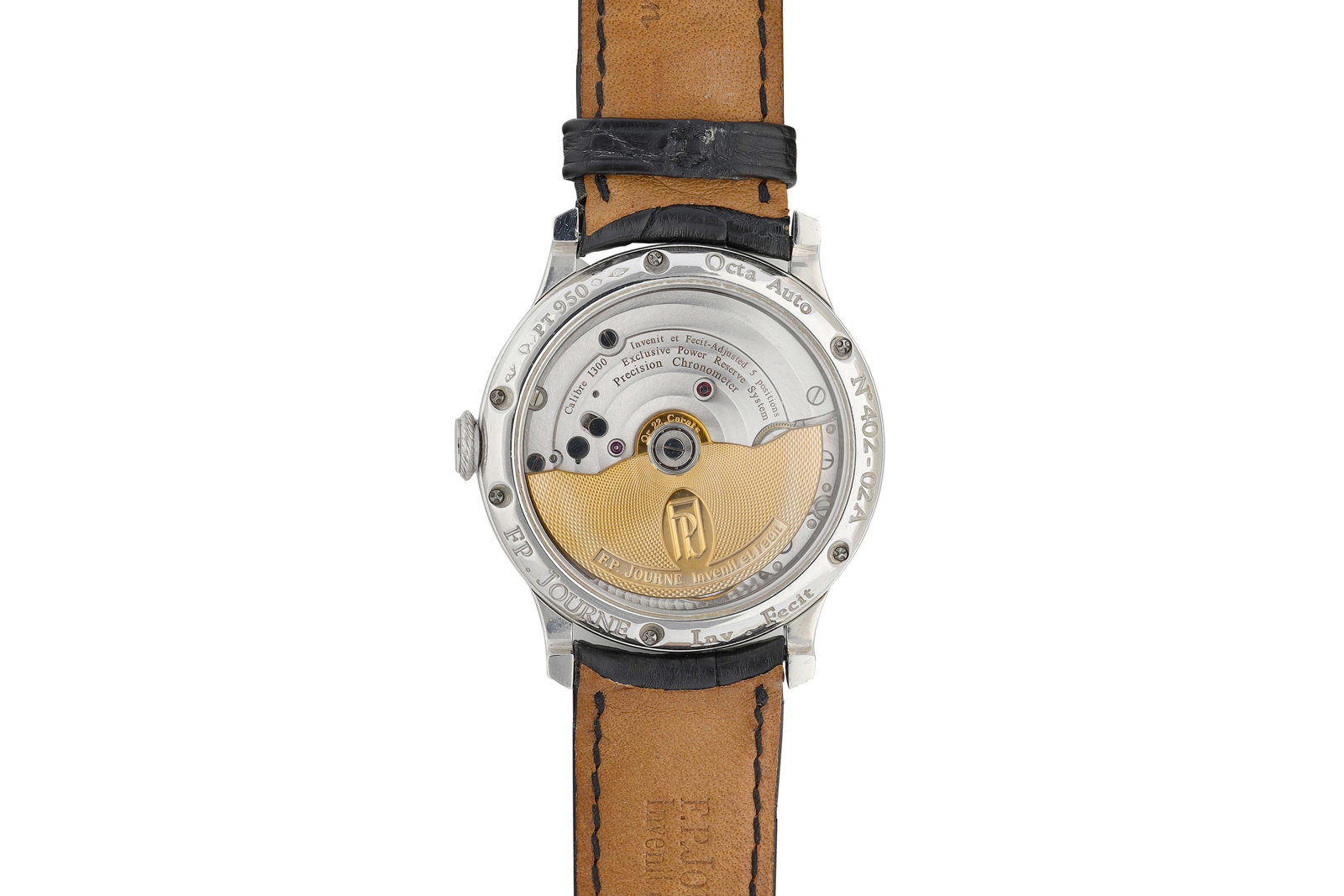
Though the base plate and bridges are rhodium-plated brass, the rotor is solid-gold decorated with guilloche
Finally, this watch, like all early Octa watches with the cal. 1300, has a faulty date. The date almost always broke down on F.P. Journe watches of this period, explaining the “00” and “38” shown in the date window of this watch.
That also implies the movement is probably just as it was in the early 2000s, having not been revamped with a modified date mechanism. When the watch was new, that was probably a major flaw for the owner, but today it’s probably regarded as a charming quirk given the mechanical originality and extreme desirability of the watch.
The Octa Reserve has an estimate of HK$300,000-500,000, or around US$38,500-64,200. Full lot details here.
Lot 2086: Octa Sport Indy 500
The next watch is a rare and obscure version of F.P. Journe’s sports watch. And like several of the brand’s past limited editions, it was born from Mr Journe’s friendship with a notable personality in another field. The recent FFC Blue for Only Watch 2021, for instance, was the result of an idea from film director Francis-Ford Coppola.
This watch comes courtesy of French racing driver Jean Alesi, who wore a Centigraphe Sport during his inaugural race at the Indy 500 in 2013, after having raced in Formula 1 and Le Mans with mixed results. While Mr Alesi’s first and only Indy 500 outing wasn’t particularly successful – the Lotus engine in his car was lacked oomph – Mr Journe has decided to honour his friend’s participation in the event with one of the most esoteric F.P. Journe limited editions, the Octa Sport Indy 500.
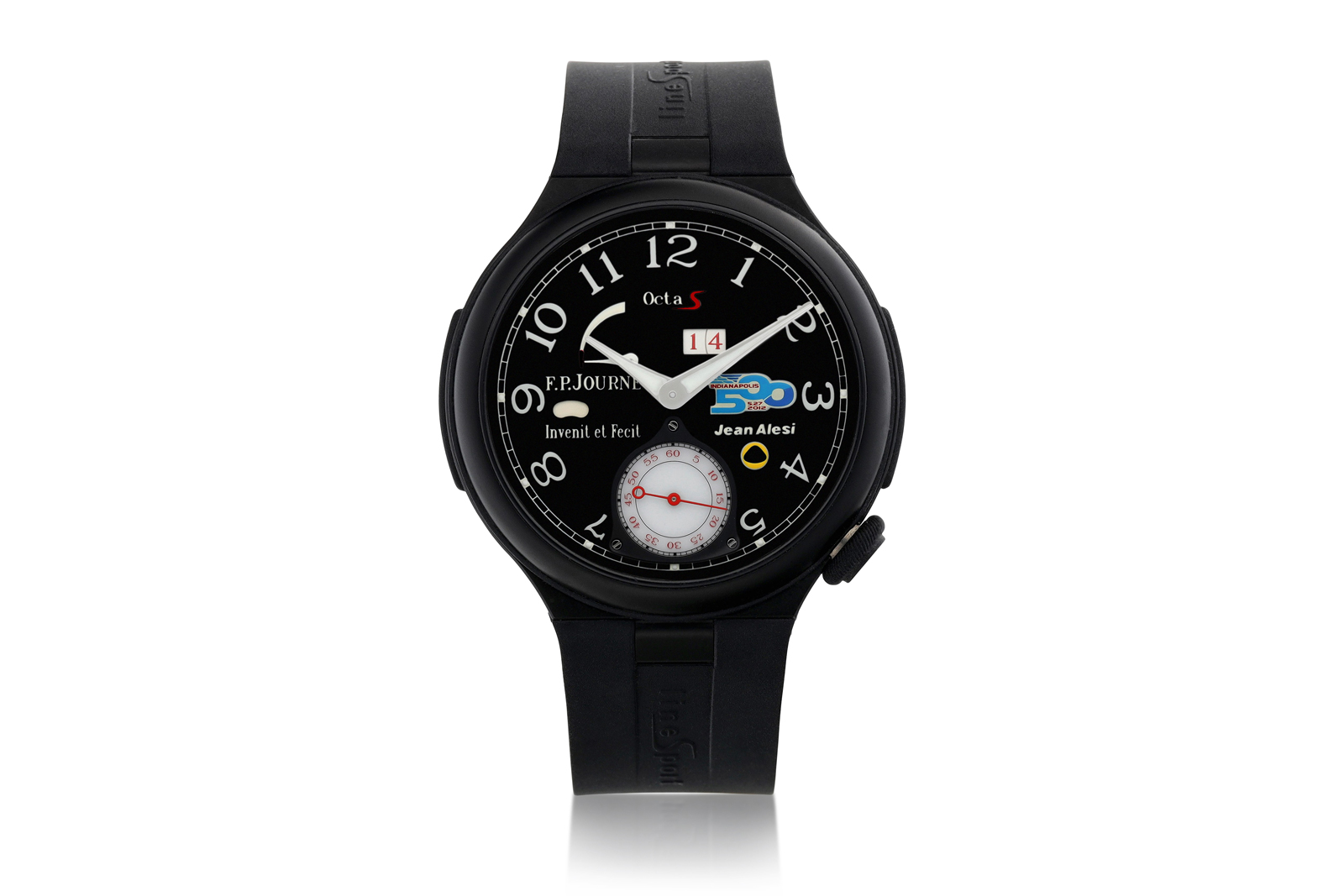
Two versions of the Indy 500 were available: one with racing branding on the dial at three o’clock, and the other left clean. The total edition size was 99 pieces, with only 29 of them having the racing logos on the dial.
This example has racing emblems, namely the Indy 500 and Lotus logos, with Mr Alesi’s name in between the two. F.P. Journe rarely features logos other than its own on the dials of its watches, so that makes the Indy 500 an extremely unusual watch, despite the crowded, logo’ed dial being unappealing.
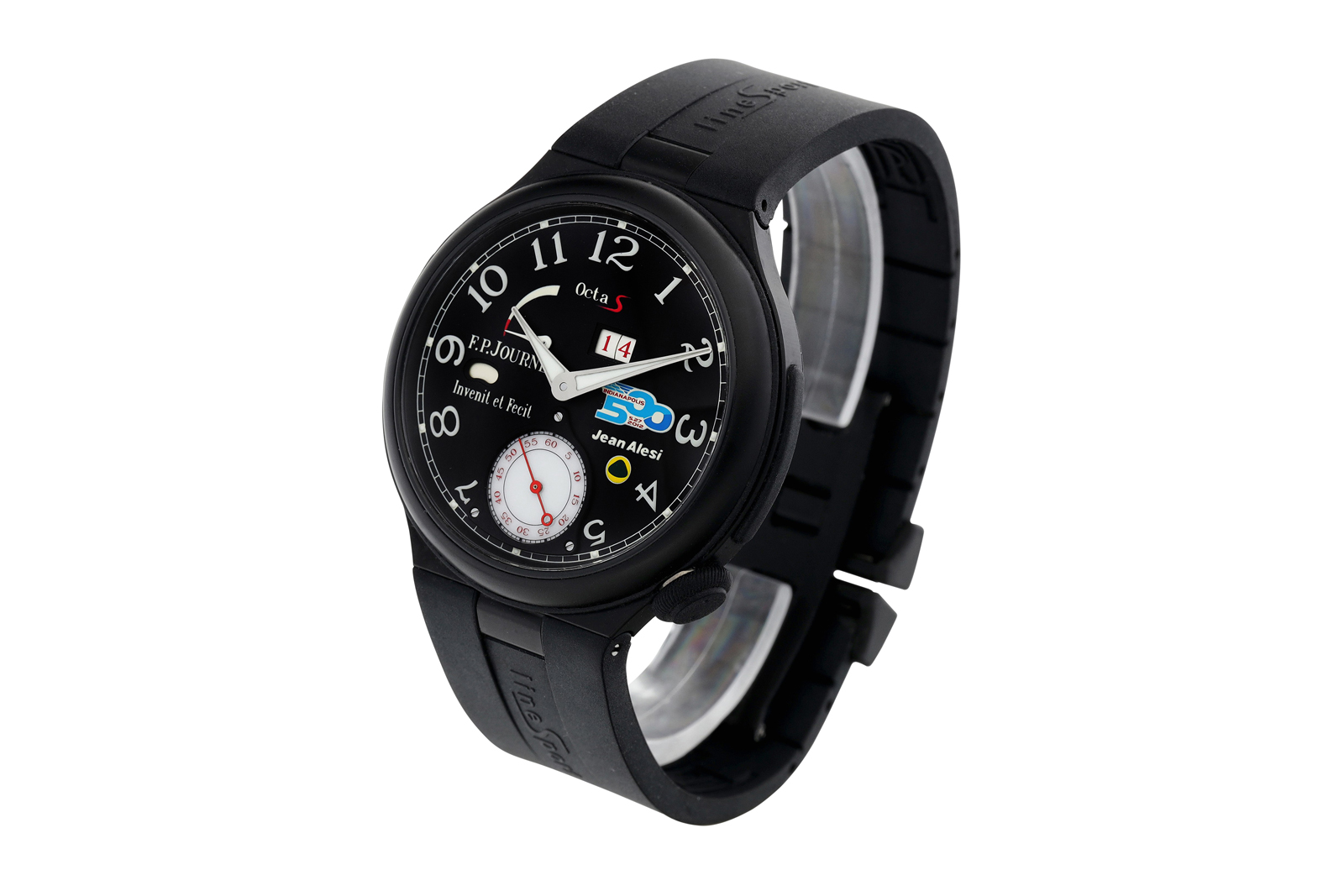
The triple logos at three o’clock replace the “Invenit et Fecit”, which is moved to the opposite site of the dial, creating even more clutter
Being a first-generation Octa Sport, the Indy 500 has an aluminum case, but coated matte black. The alloy was the standard metal for the brand’s sports watches before it switched to titanium in 2014. And like other Octa Sport watches of the era, the Indy 500 has rubber bumpers attached to the case flanks.
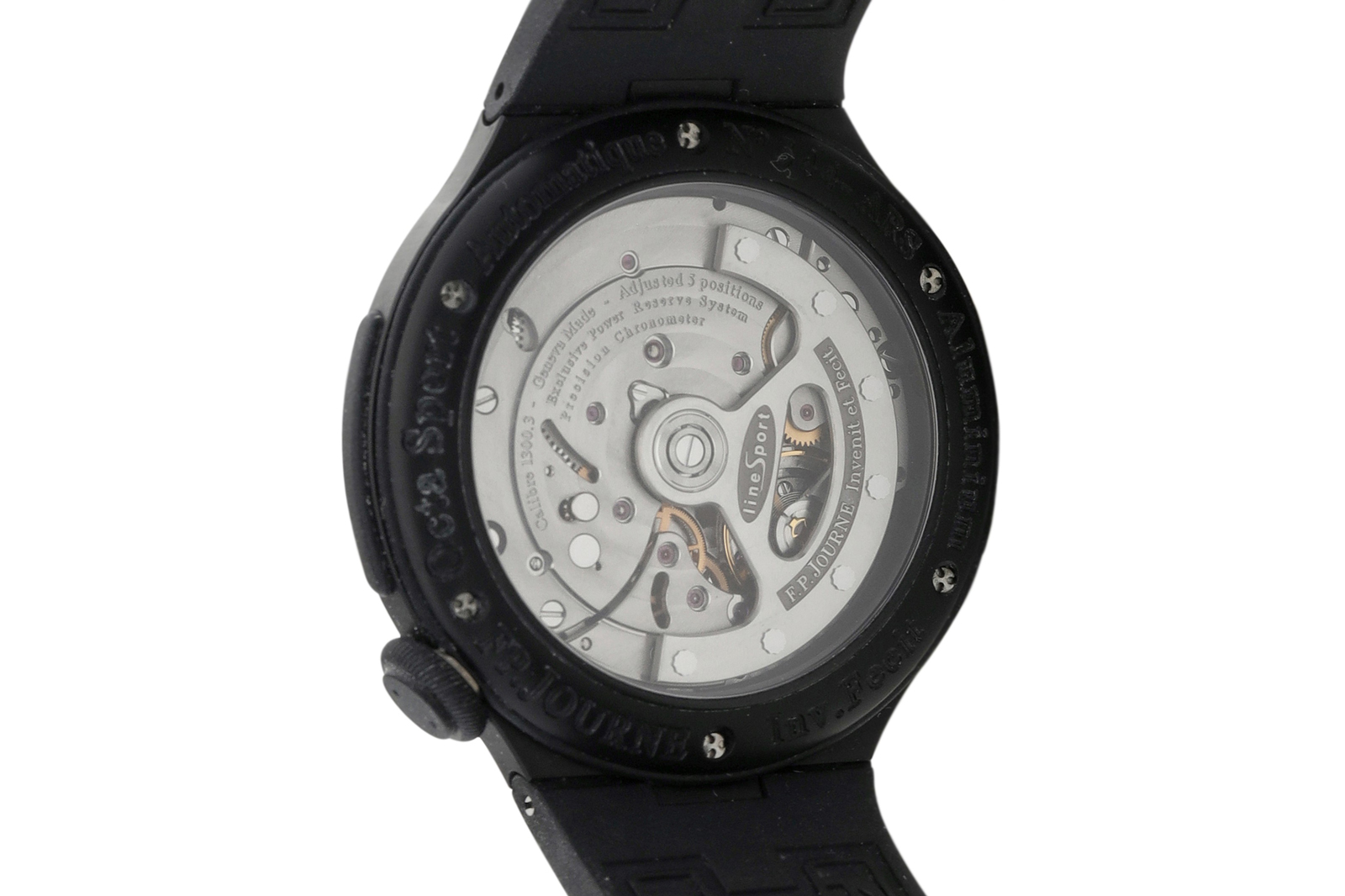
The movement its bridges and base plate in aluminium
The Indy 500 has an estimate of HK$200,000-300,000, or around US$25,700-38,500. Full lot details here.
Lot 2088: Vagabondage II
No F.P. Journe collection is complete without one of the unconventional time displays in tortoise-shaped cases. Launched in 2010, the Vagabondage II sits neatly between the first and third editions of the eponymous trio in terms of aesthetics and complexity.
The Vagabondage I was the simplest, featuring a wandering hours and a full dial save for an exposed balance wheel in the middle. And the closing chapter of the trio was the most complicated, being the world’s first watch with a jumping-digital seconds – with its complexity revealed through the open dial.
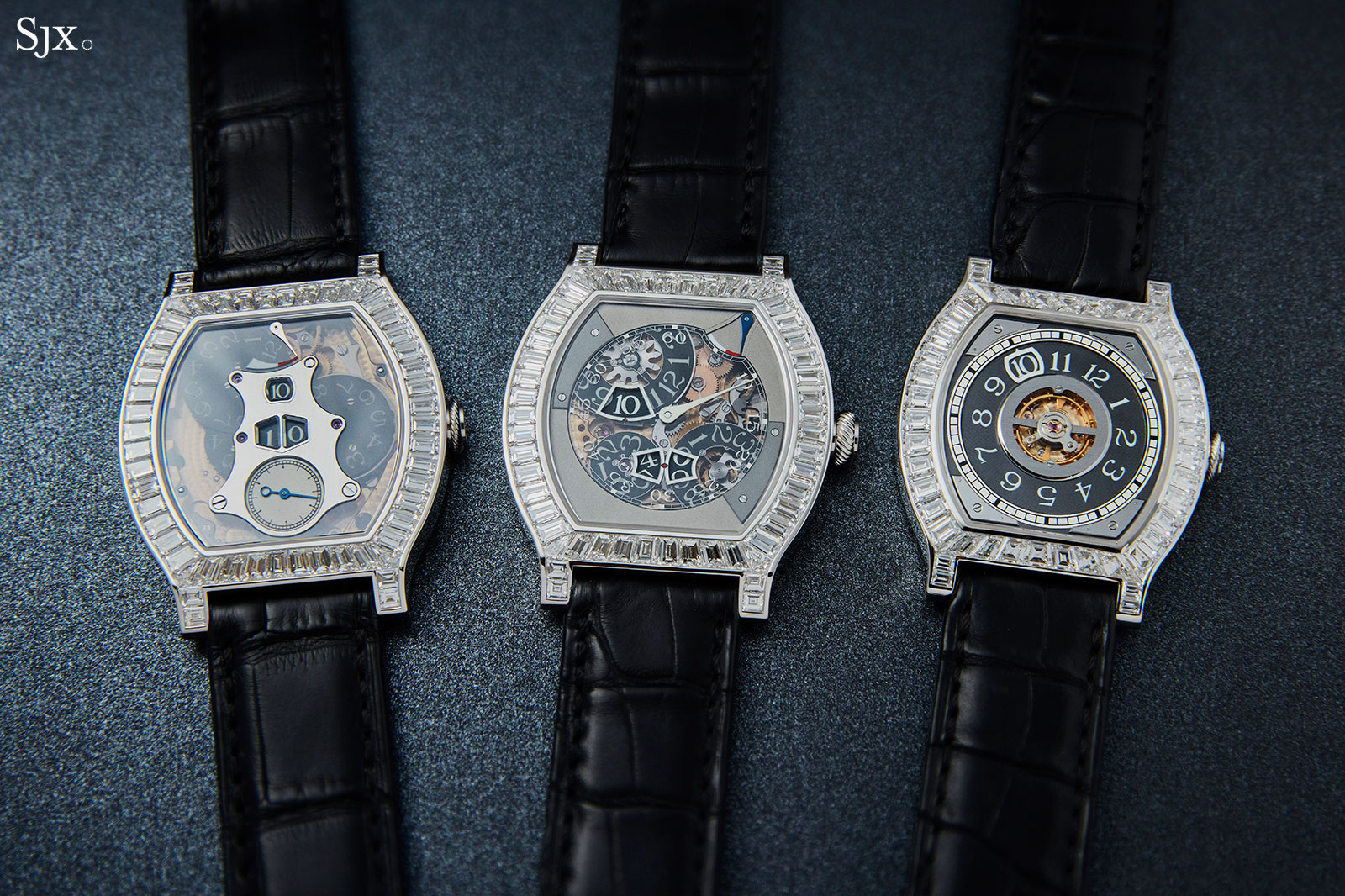
The Vagabondage trio in its diamond-set form: (from left) II, III and I
Unlike any other F.P. Journe watch before or after, the Vagabondage series has an intriguing backstory that began with the one-off Carpe Diem, a round wristwatch with wandering hours and an exposed balance, which was commissioned by a Parisian collector in 1997, when Mr Journe was still involved with movement maker THA. Legend has it that Cartier approached THA to develop something similar for its Tortue watch, but the project never went anywhere.
When Mr Journe was asked to create a unique watch for Antiquorum’s 30th anniversary auction in 2004, he started where he had left off, resulting in the first F.P. Journe wristwatch – more specifically, a set of three identical watches – in a Tortue, or “tortoise”, case. Also unique was the fact that the Vagabondage had no branding on the dial, a feature that continued for the entire series.
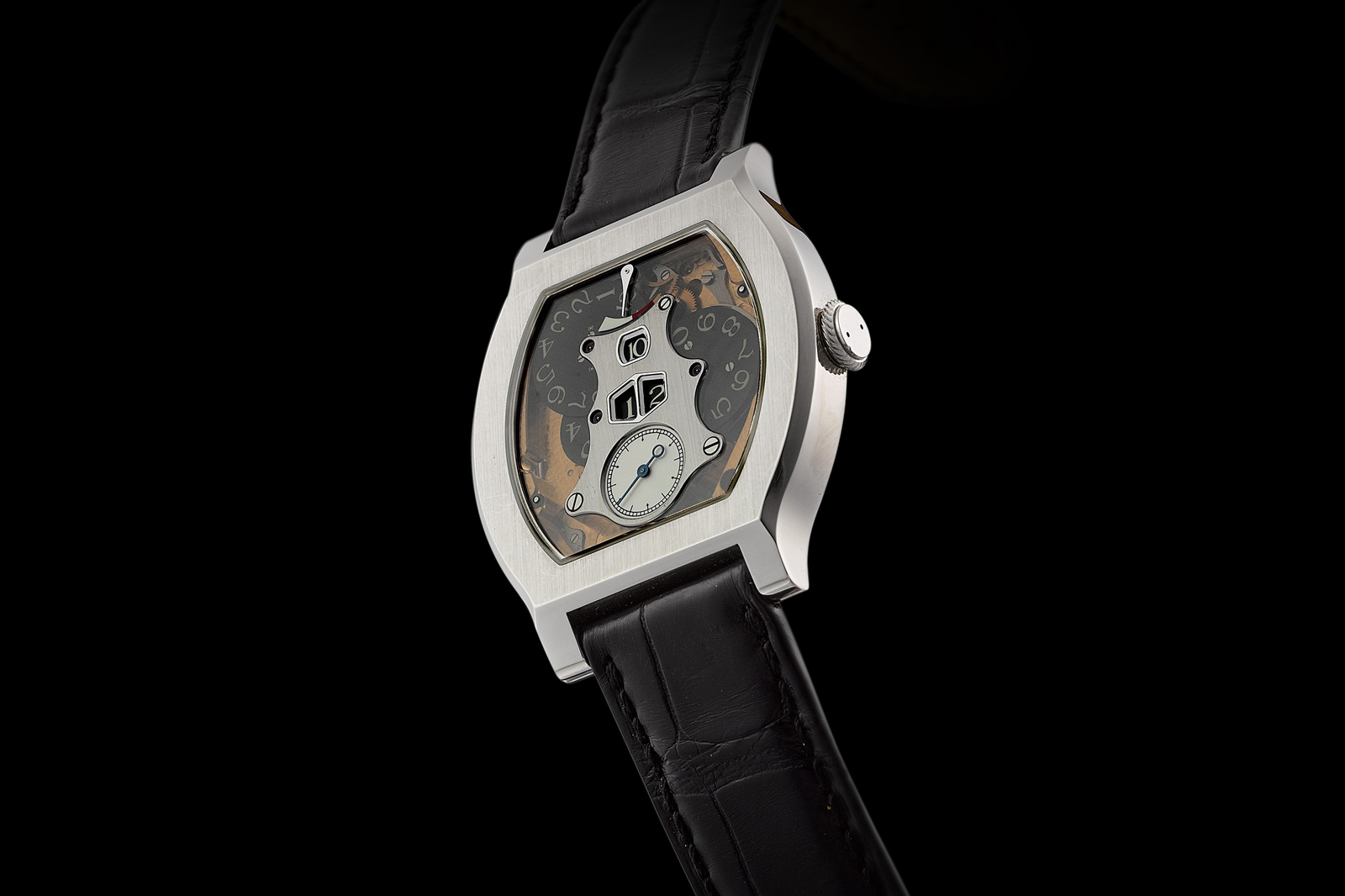
Akin to a bridge between the ideas behind the first and third models, the Vagabondage II illustrates the evolution of the series.
Mechanically it was substantially improved compared to the Vagabondage I, having both a digital hours and minutes, as well as a constant-force mechanism that facilitate the jumping mechanisms.
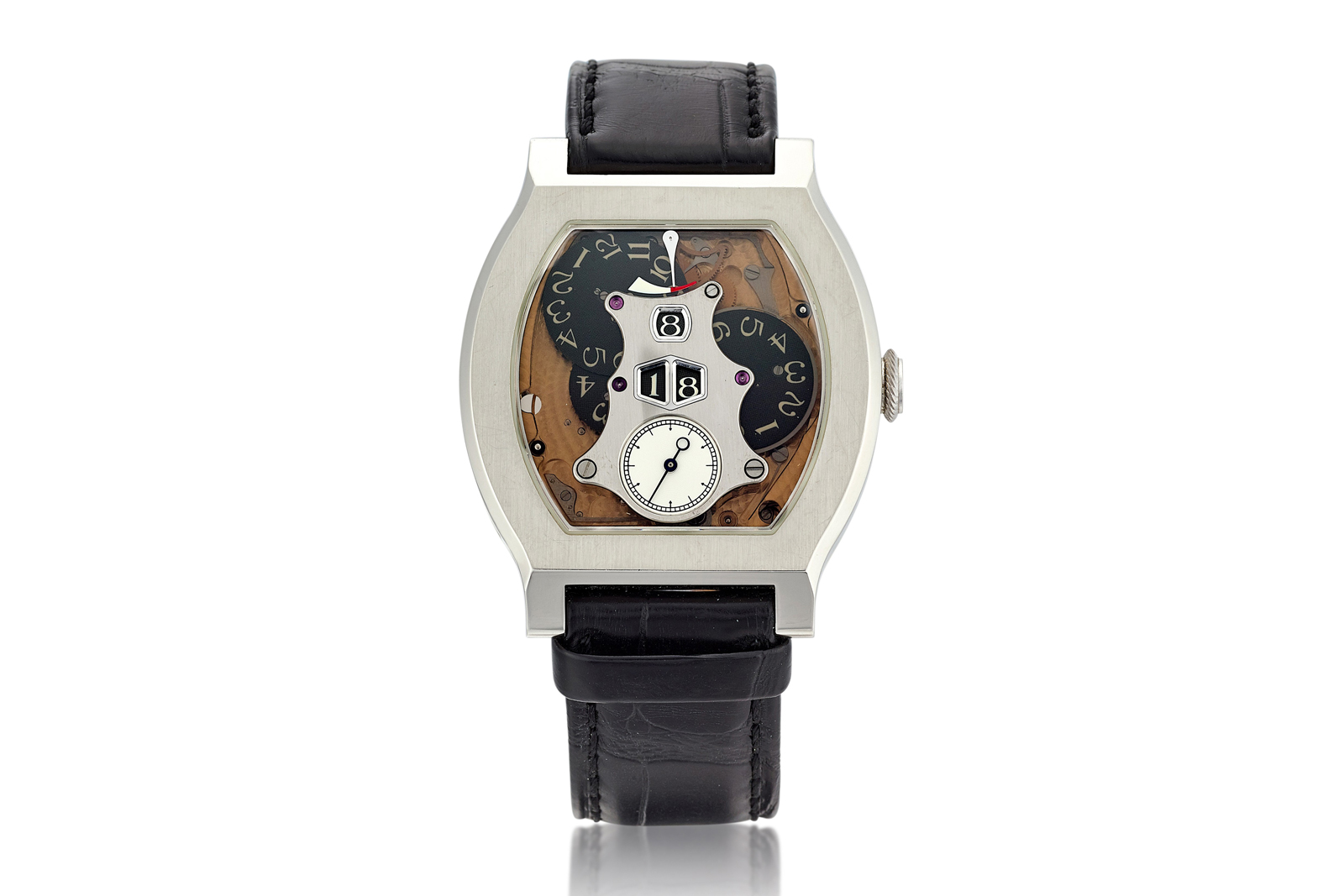
And aesthetically it was similarly refined. A partially-skeletonised dial is home to a time display that has the power reserve, hours, minutes, and seconds arranged linearly and almost symmetrically.
But arguably the most important feature of the Vagabondage II was its constant force mechanism that was derived from the one found in the F.P. Journe tourbillon. This would later be found in the Vagabondage III was well.
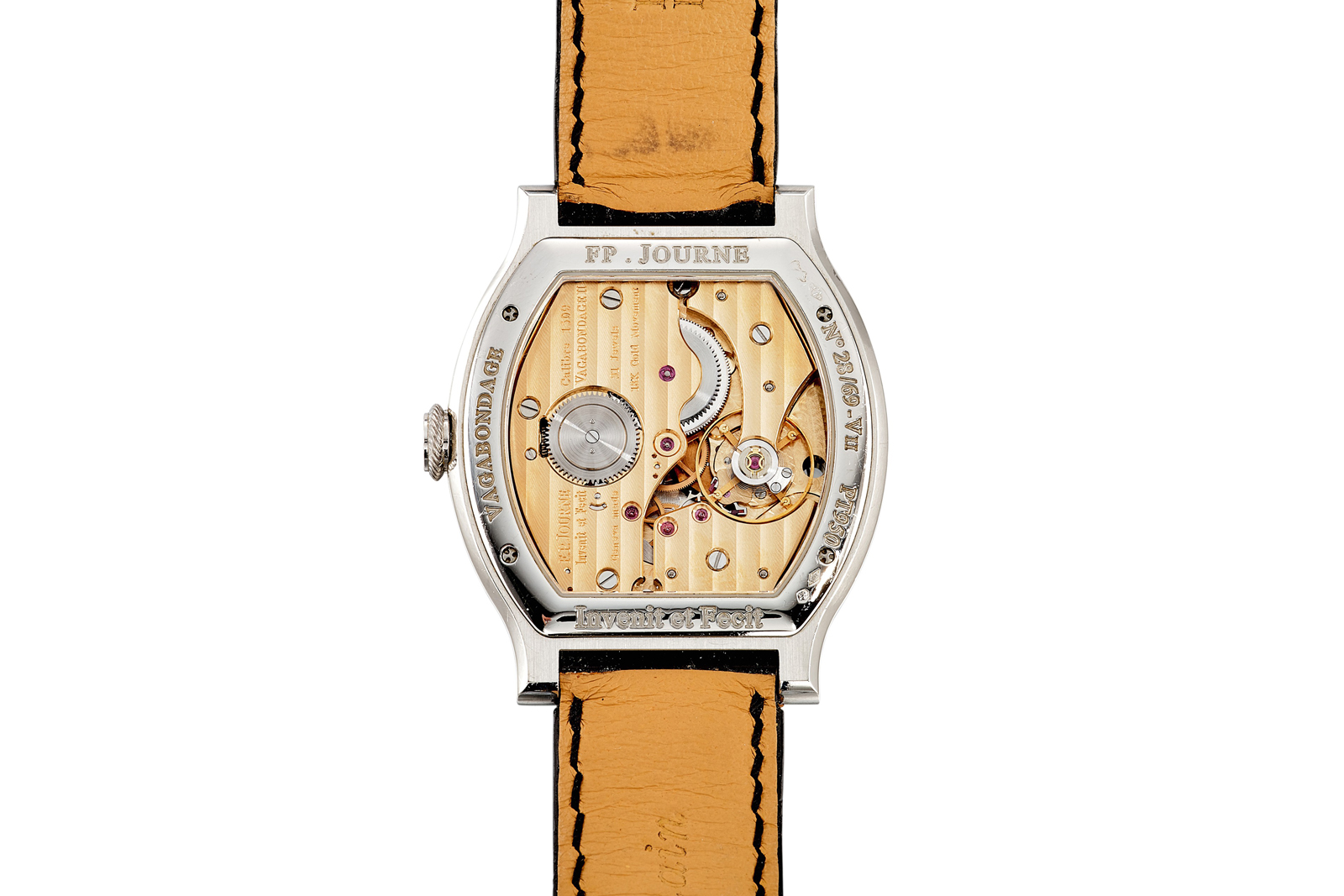
The Vagabondage II on offer is 28 of 69, and in platinum. It’s accompanied by its certificate, manual, and box.
The watch has an estimate of HK$650,000-800,000, or around US$83,500-102,800. Full lot details here.
Lot 2089: Centigraphe Souverain Anniversaire Tokyo
Now a tradition for F.P. Journe boutiques, each store receives its own boutique-edition Centigraphe on its respective 10th anniversary. The Centigraphe edition began with the Tokyo boutique, which was the brand’s first ever and thus the first to celebrate 10 years in 2016. It then became was the first store to offer the Centigraphe Souverain Anniversaire.
Notably, it was also the Tokyo boutique that inaugurated the concept of boutique editions for the brand when it debuted the limited-edition Chronometre Souverain in titanium for its opening in 2005. Since then, F.P. Journe has unveiled five boutique-anniversary models to date, all sporting a two-tone dial and case, including the Perpétuelle two lots down.
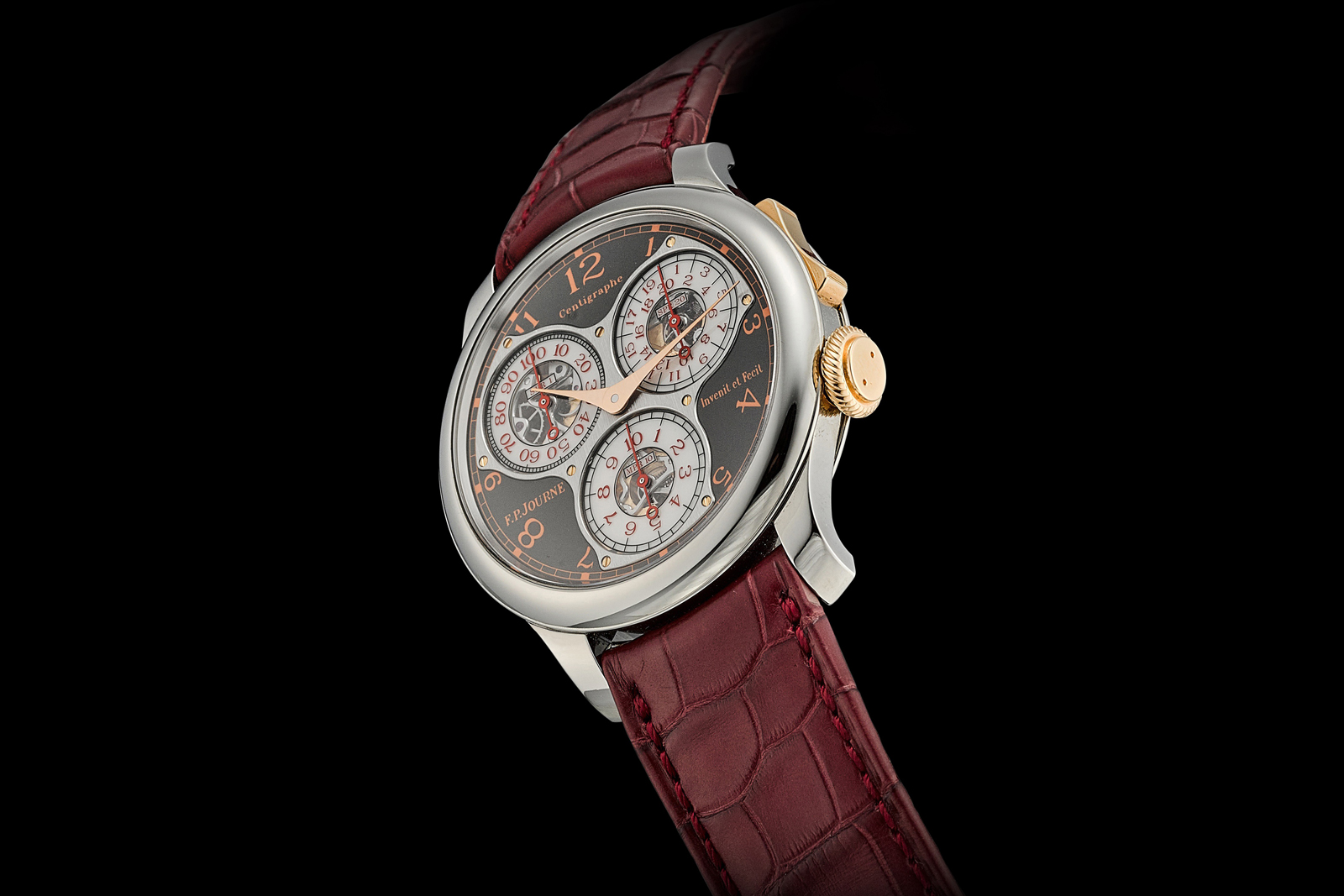
Mechanically, the Centigraphe Souverain is identical to as the production version, but it’s far more striking visually.
The combination of pink gold and ruthenium-grey on the dial gives the watch an appearance that’s both sporty and luxe. Add to that the see-through sapphire counters, and the result is a dial with a great deal more detail than that of the standard-production model.
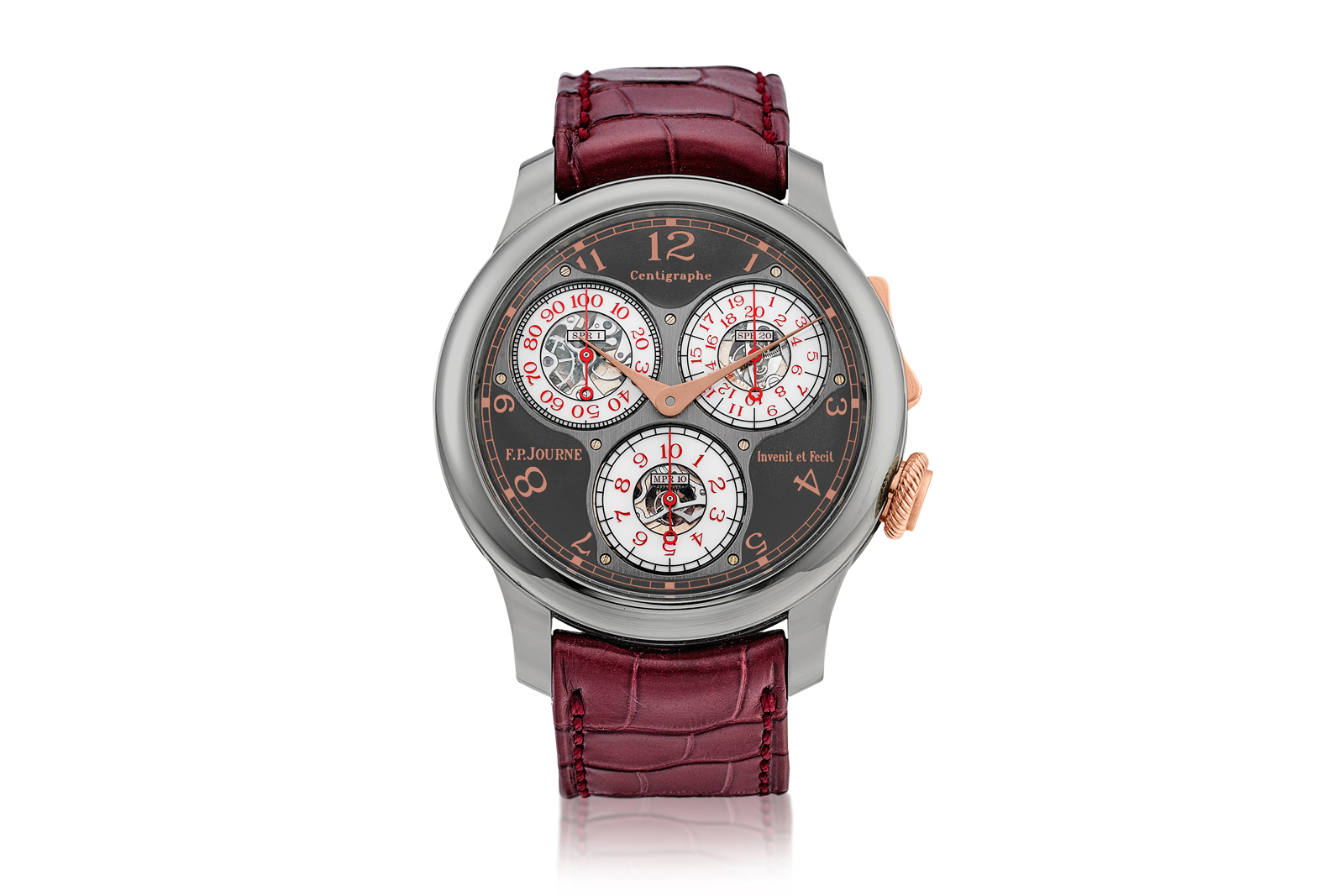
A rocker for the start-stop of the chronograph provides more precise action in theory
Colours aside, the Centrigraphe itself is clever in mechanical terms. The movement leverages its conventional frequency of 3 Hz to measure 1/100th of a second, which in theory requires a 50 Hz balance. That was achieved with a lightning seconds at 10 o’clock, which completes one revolution per second.
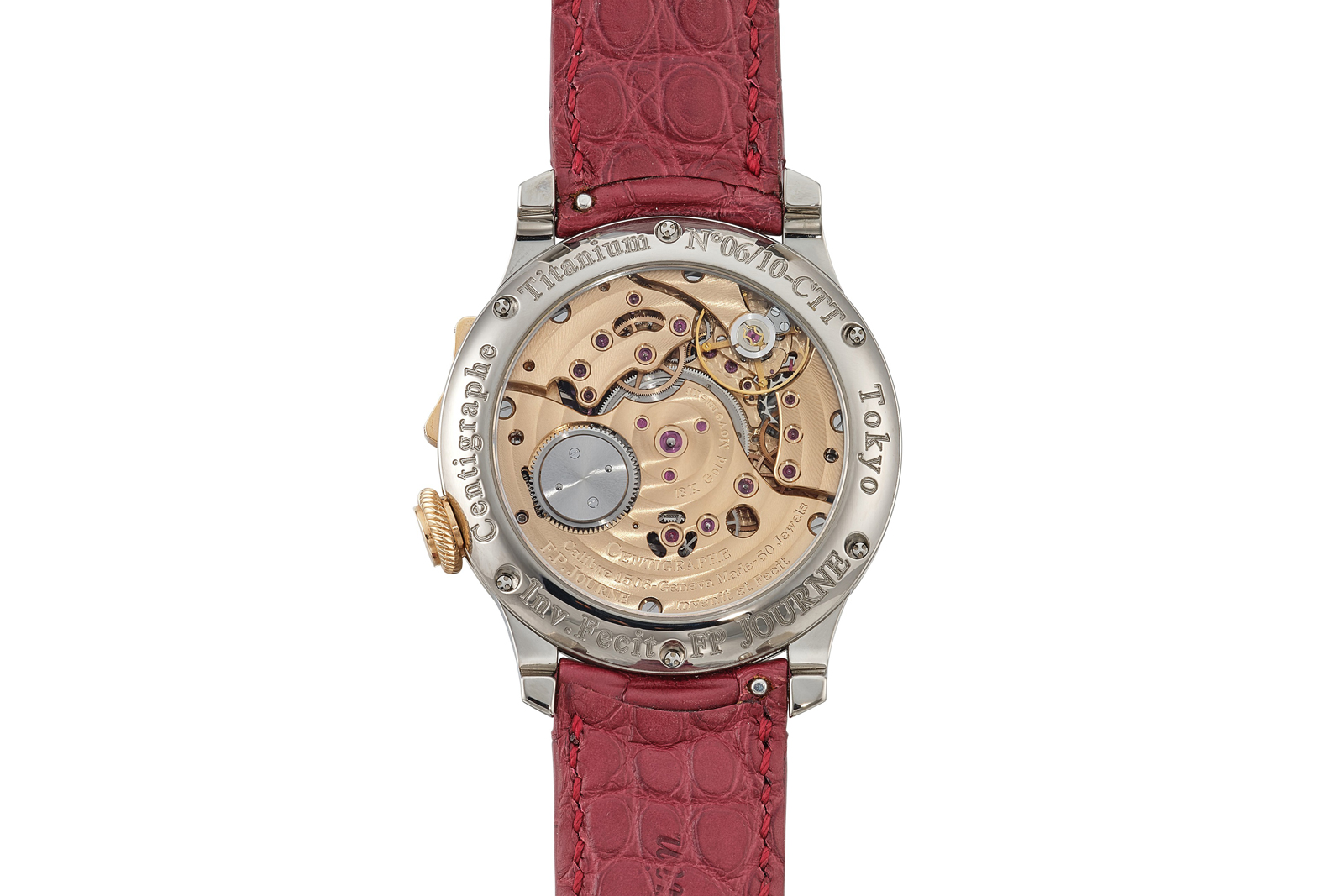
The movement is unusual in having the barrel in the centre, with the going train sitting around it and the separate chronograph train on top of it
Because the balance oscillates at 3 Hz, the lightning seconds jumps six times a second. But it can be stopped at any point in between the steps, allowing for an (approximate) reading of up to a hundredth of a second.
In fairness, the chronograph is not a bona fide 1/100th of a second chronograph, but it’s notable for its innovative engineering and thinness, which arguably makes it as interesting as the real deal, which is technically impressive but inevitably bulky.
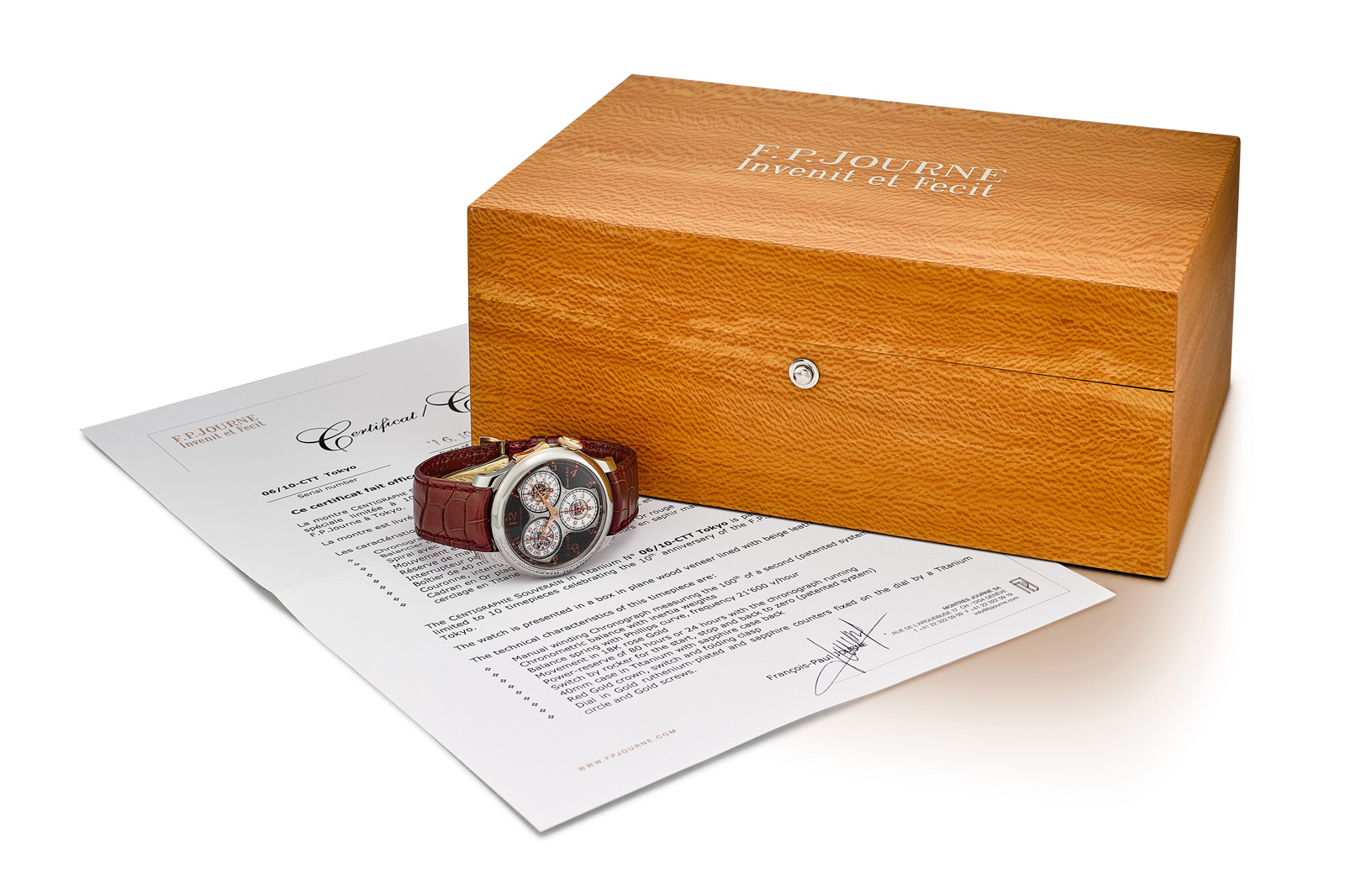
This example is accompanied by its certificate and box. It has an estimate of HK$700,000-1.2 million, or around US$89,900-154,000. Full lot details here.
Lot 2090: Octa Ruthenium Jour et Nuit
This lot, like the Tourbillon Ruthenium further down, is part of the five-model Ruthenium collection. Produced between 2001 and 2003, it was conceived as something of a farewell to the brass movements, which were replaced by solid-gold movements during that period.
With each model limited to 99 pieces, the Ruthenium watches were named after the metal that is found front and back. The movement bridges and base plate are plated in ruthenium, as are the dials. But each of the five were also unusual in terms of size at 40 mm, as opposed to the typical 38 mm of the time.
Most of the Ruthenium watches were variants of standard models, except for this one.
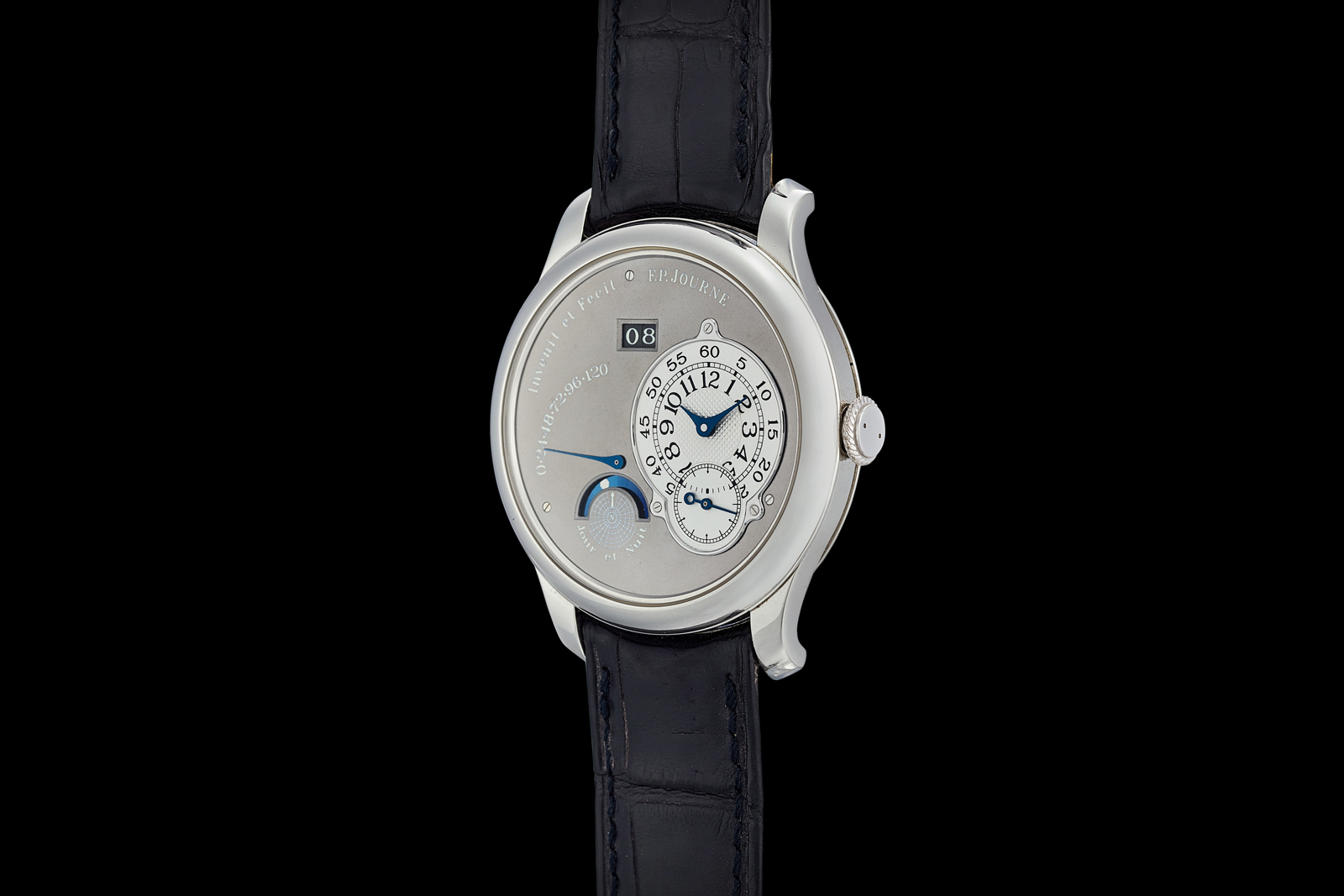
Despite being one of the simplest in the Ruthenium quintet, the Octa Jour et Nuit distinguishes itself by being a true one-off offering, as the model never made into regular production.
Mechanically the watch is similar to the Octa Reserve de Marche, but with the addition of a day-and-night indicator – jour et nuit is French for “day and night” – in a narrow window at seven o’clock.
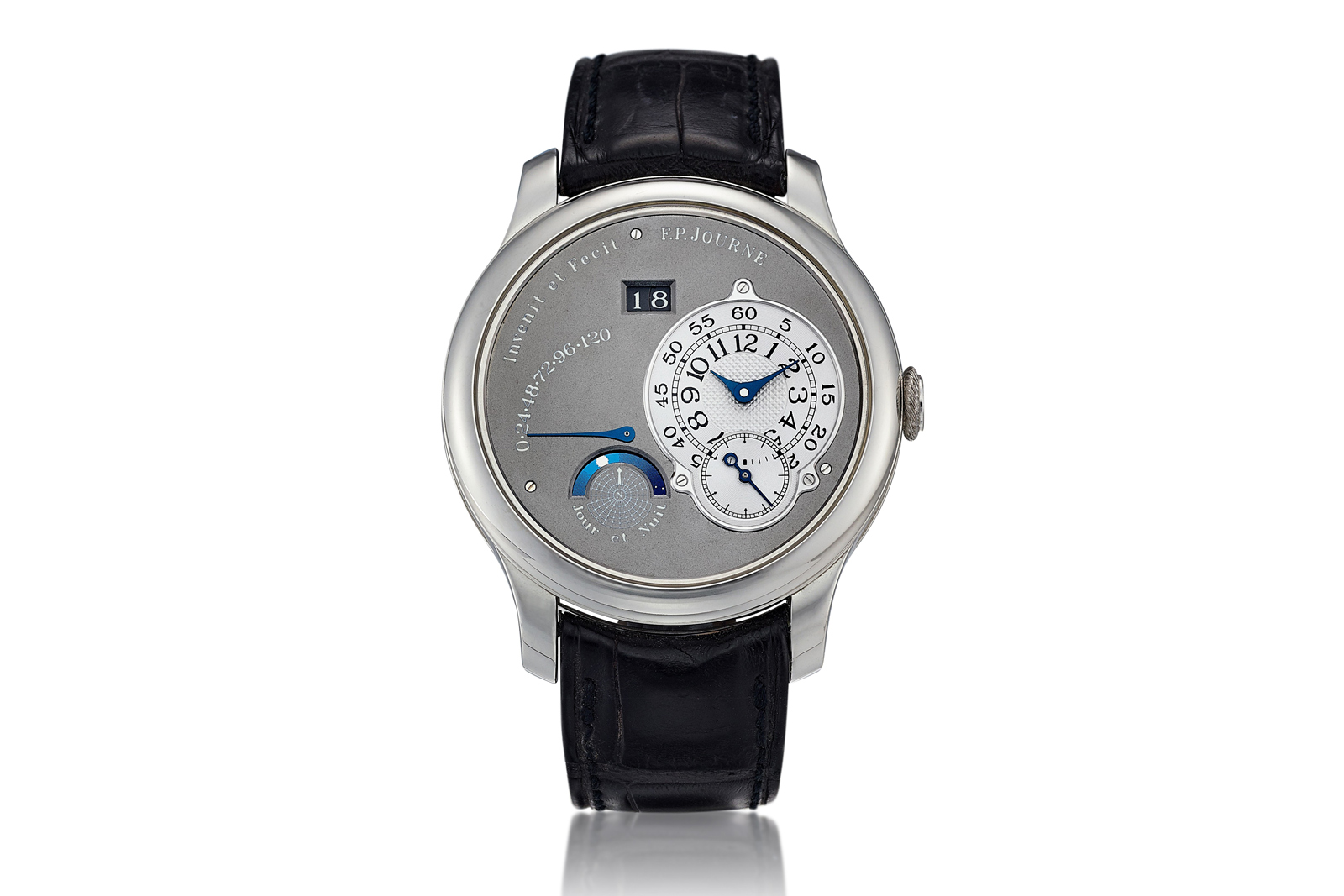
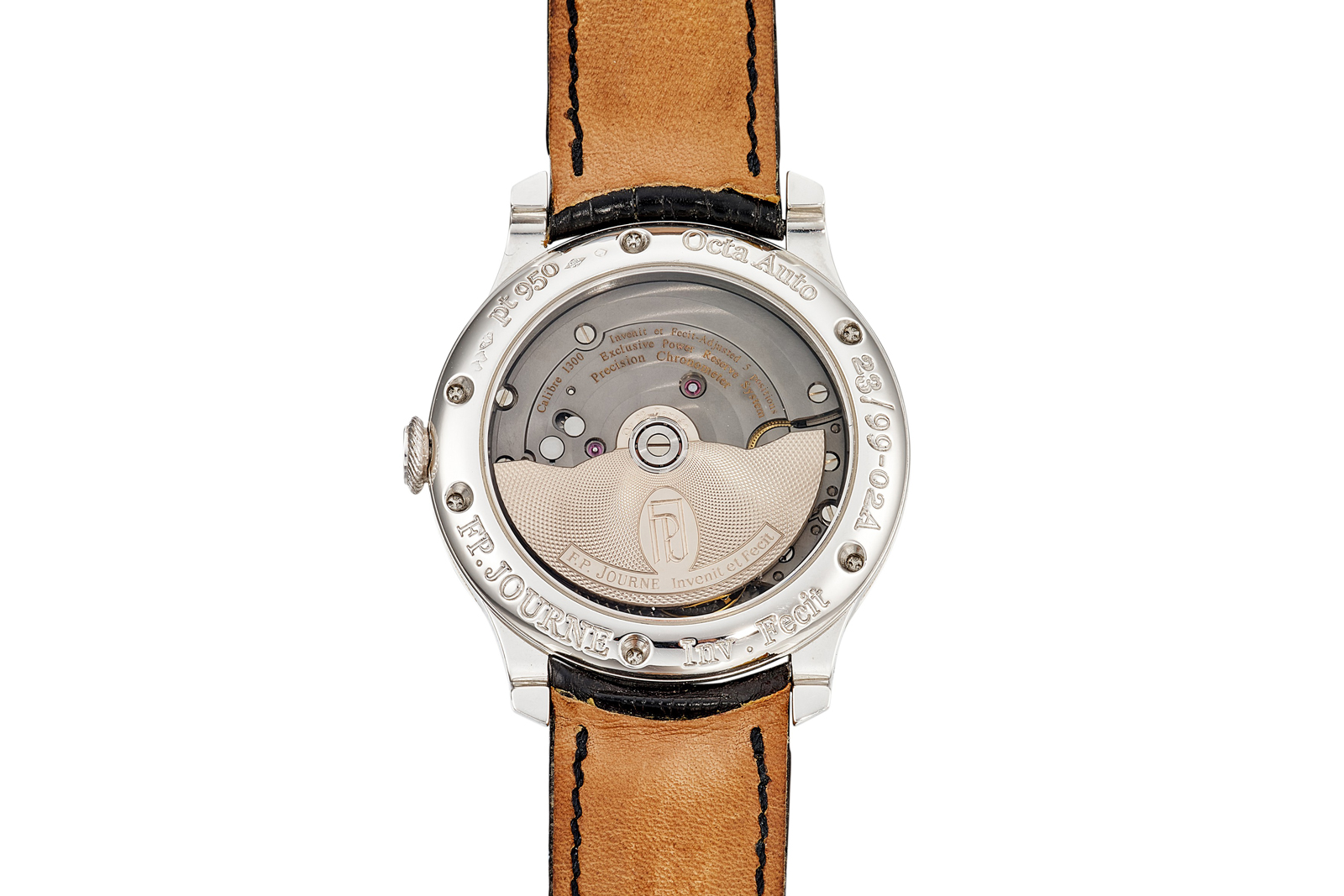
The movement is based on the cal. 1300 with its distinctive off-centre rotor
The present example is numbered “23/99”. It’s accompanied by the original certificate, box, and accessories that were standard for the Ruthenium editions. The estimate is HK$700,000-950,000, or around US$89,900-122,000. Full lot details here.
Lot 2092: Octa Perpétuelle Anniversaire Tokyo
The Octa Perpétuelle Anniversaire Tokyo, like the Centigraphe above, was a limited edition conceived for the brand’s Tokyo boutique. And like the Centigraph, the Perpétuelle stands out for its palette – a striking mix of pink gold and grey. But the Perpétuelle, like the Jour et Nuit, is a unique edition.
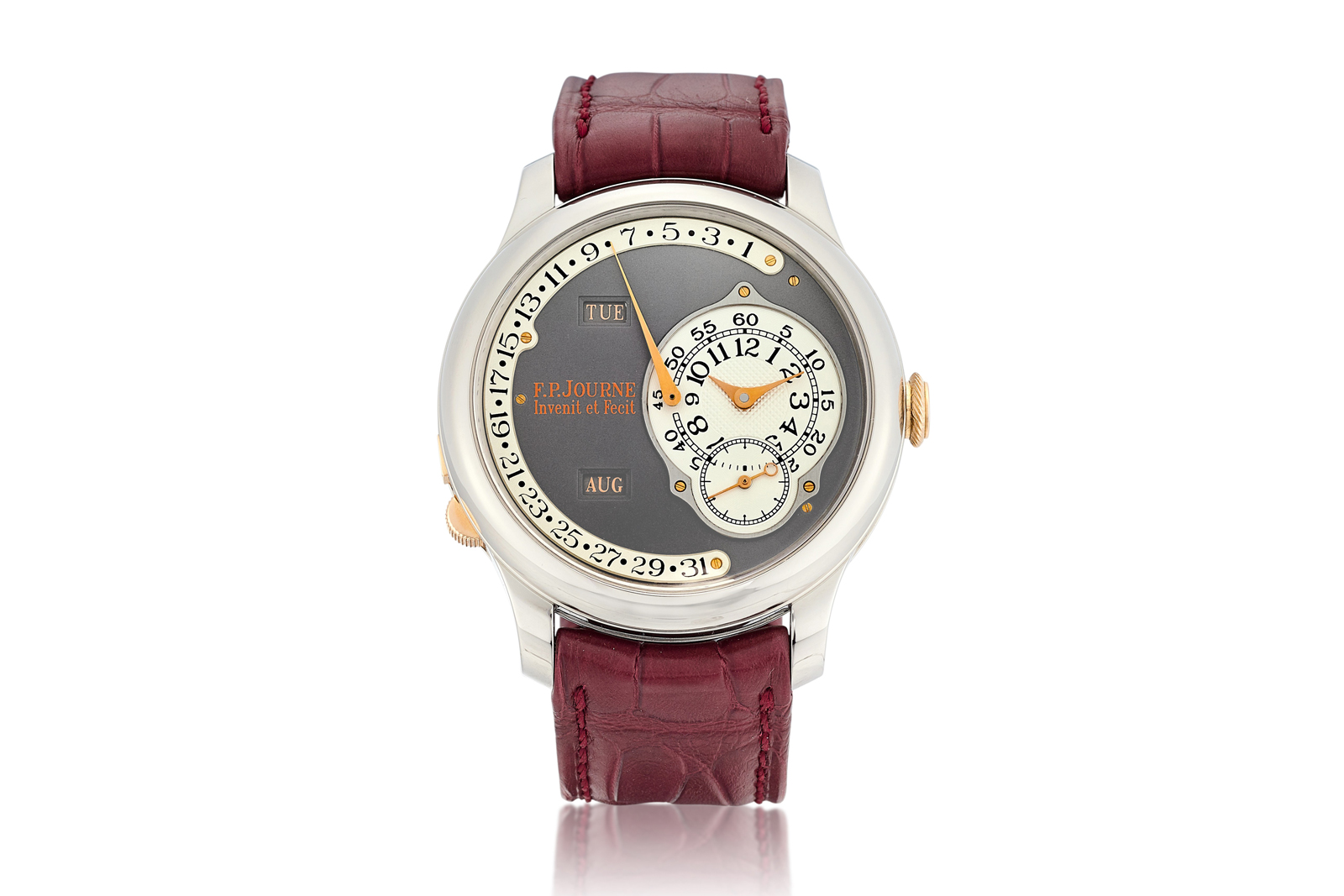
The large retrograde date is especially fascinating
The Perpétuelle preceded the Centigraphe, having been launched in 2010 to celebrate the fifth anniversary of the Tokyo store. It was more than just a limited edition in novel colours, because the Perpétuelle was an all-new model at its launch. In fact, the Perpétuelle remains a one-off edition – only 99 pieces were ever made – because the standard-production perpetual calendar is an entirely different watch.
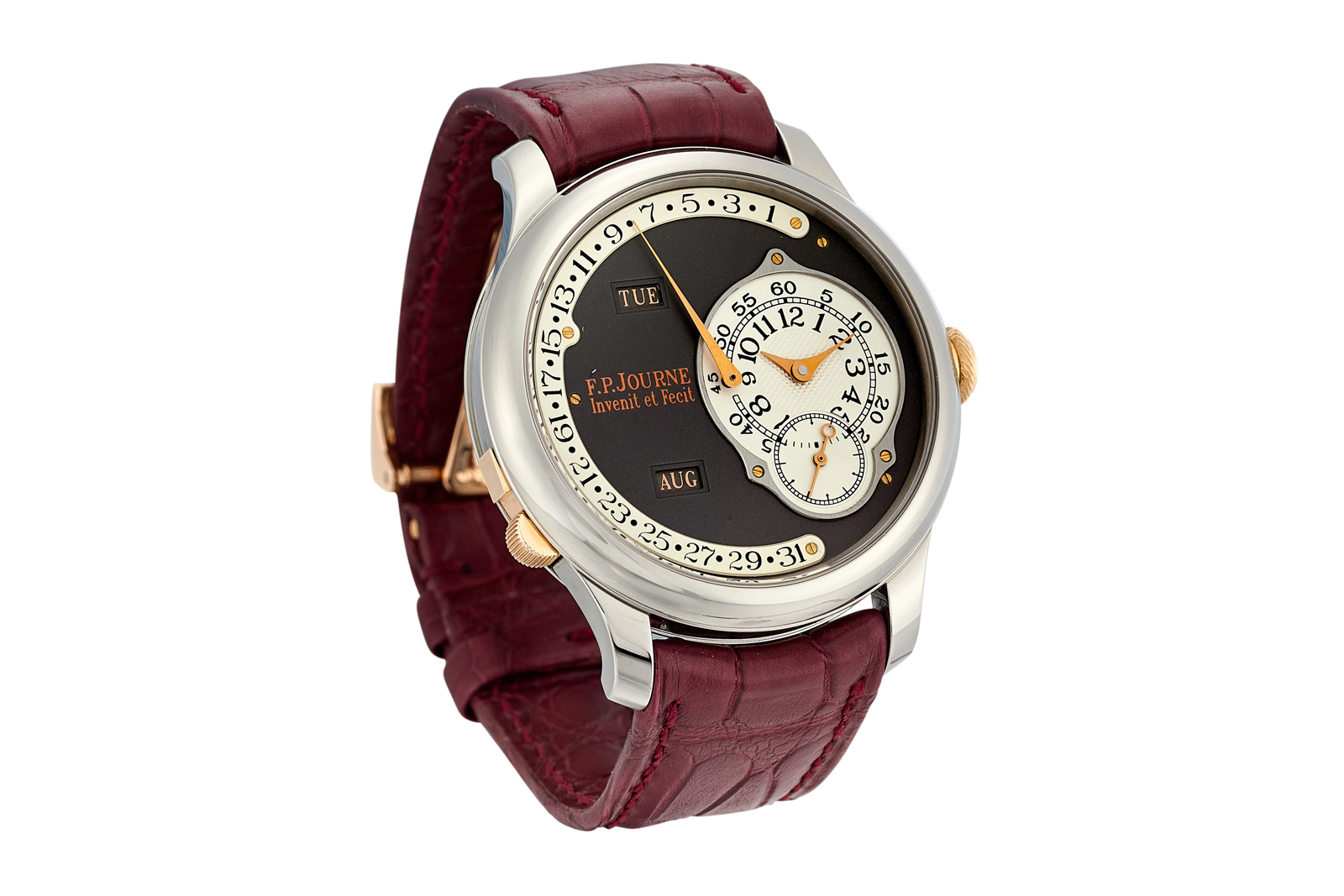
The Perpétuelle was based on the Octa Calendrier, an annual calendar wristwatch that was a longstanding part of the F.P. Journe lineup. As a result, it shares the interesting calendar display that originated with the Calendrier.
The indications are asymmetrically arranged but harmonious in their balance and layout – the time and calendar each take up about half the dial.
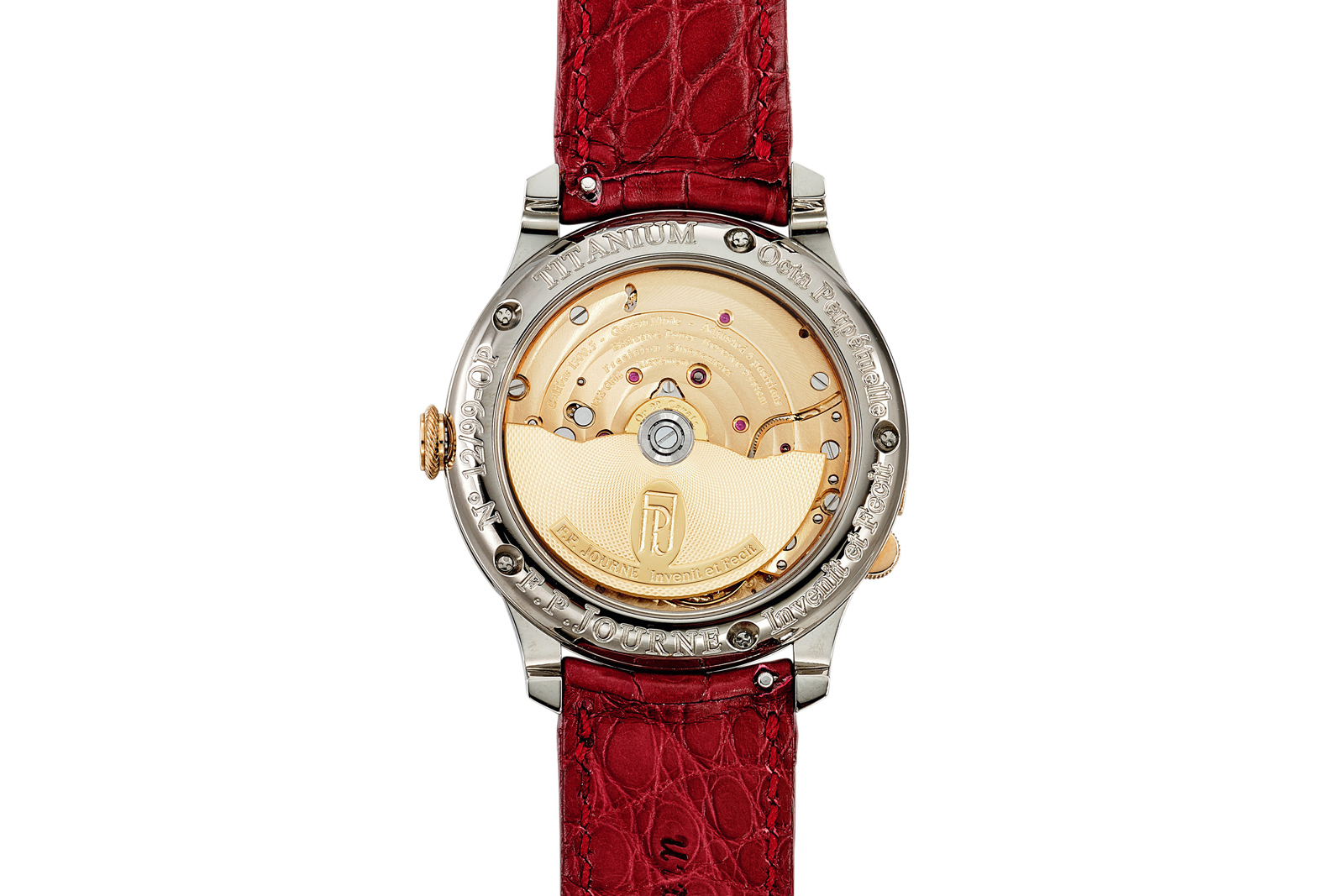
Complete with the original box and papers, this Perpétuelle has an estimate of HK$600,000-800,000, or around US$77,000-102,800. Full lot details here.
Lot 2093: Tourbillon Remontoir d’Egalite Ruthenium
Being the foundational wristwatch of the brand, the tourbillon with remontoir d’egalite is arguably most representative of F.P. Journe in terms of history, mechanics, and style. In fact, Mr Journe’s fondness for tourbillon can be traced back to the first-ever watch he built some two decades before the debut of his own brand.
As a result, the stellar lineup of F.P. Journe in the sale inevitably includes not one, but two, early-generation tourbillons.
The first is a Ruthenium Tourbillon Remontoir d’Egalite, which is special for a few reasons. First, being part of the Ruthenium collection, it was the swan song for brass-movement Tourbillon Remointoir d’Egalite. Add to that the ruthenium-coated dial and movement, and it is a tourbillon different from all the others.
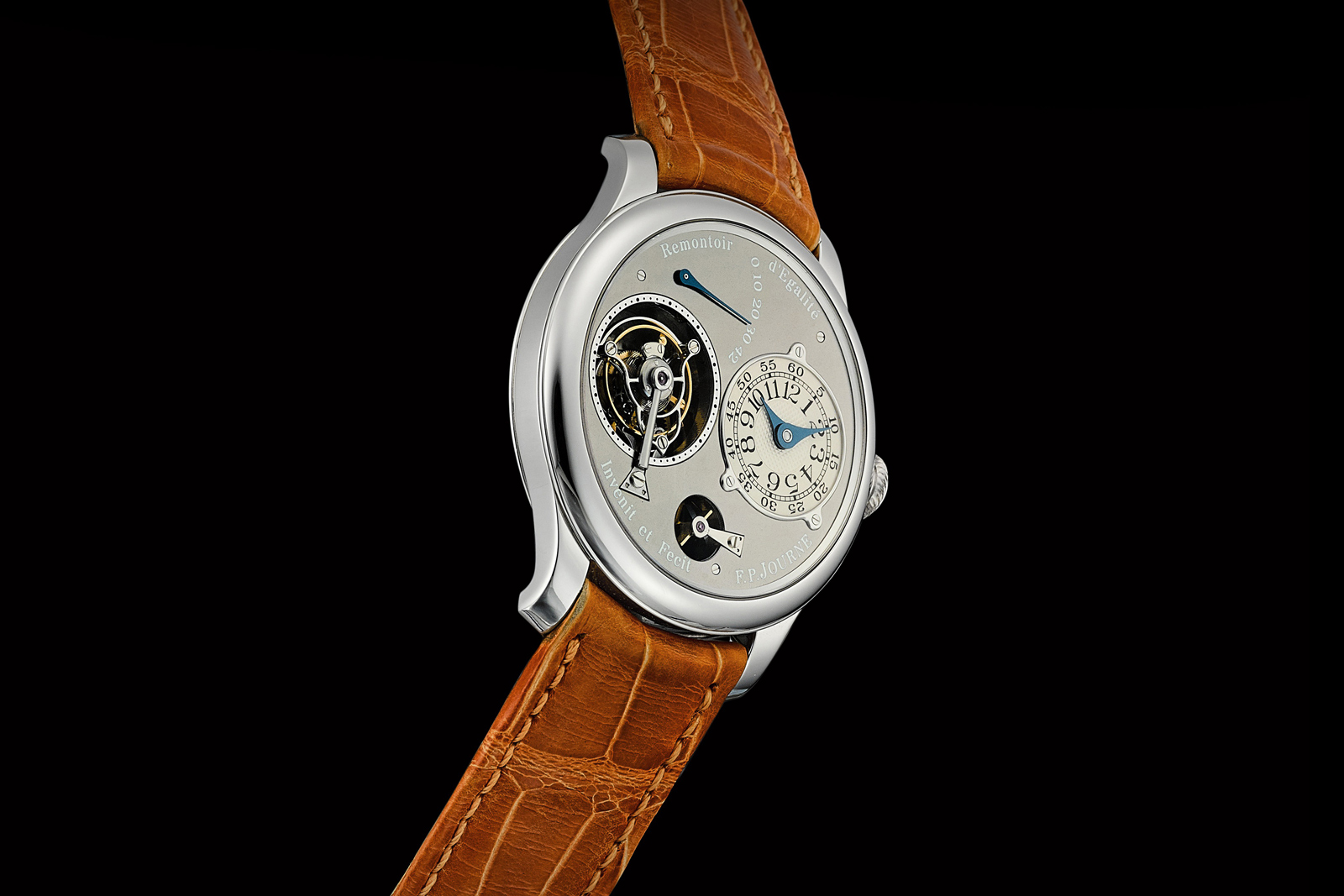
The shiny grey dial gives the watch a different feel from the typical F.P. Journe tourbillon of the period, giving it a more modern aesthetic, especially when matched with the 40 mm case. Crucially, the Ruthenium Tourbillon was the first-ever F.P. Journe tourbillon with a 40 mm case, and the only 40 mm Tourbillon with a brass movement.
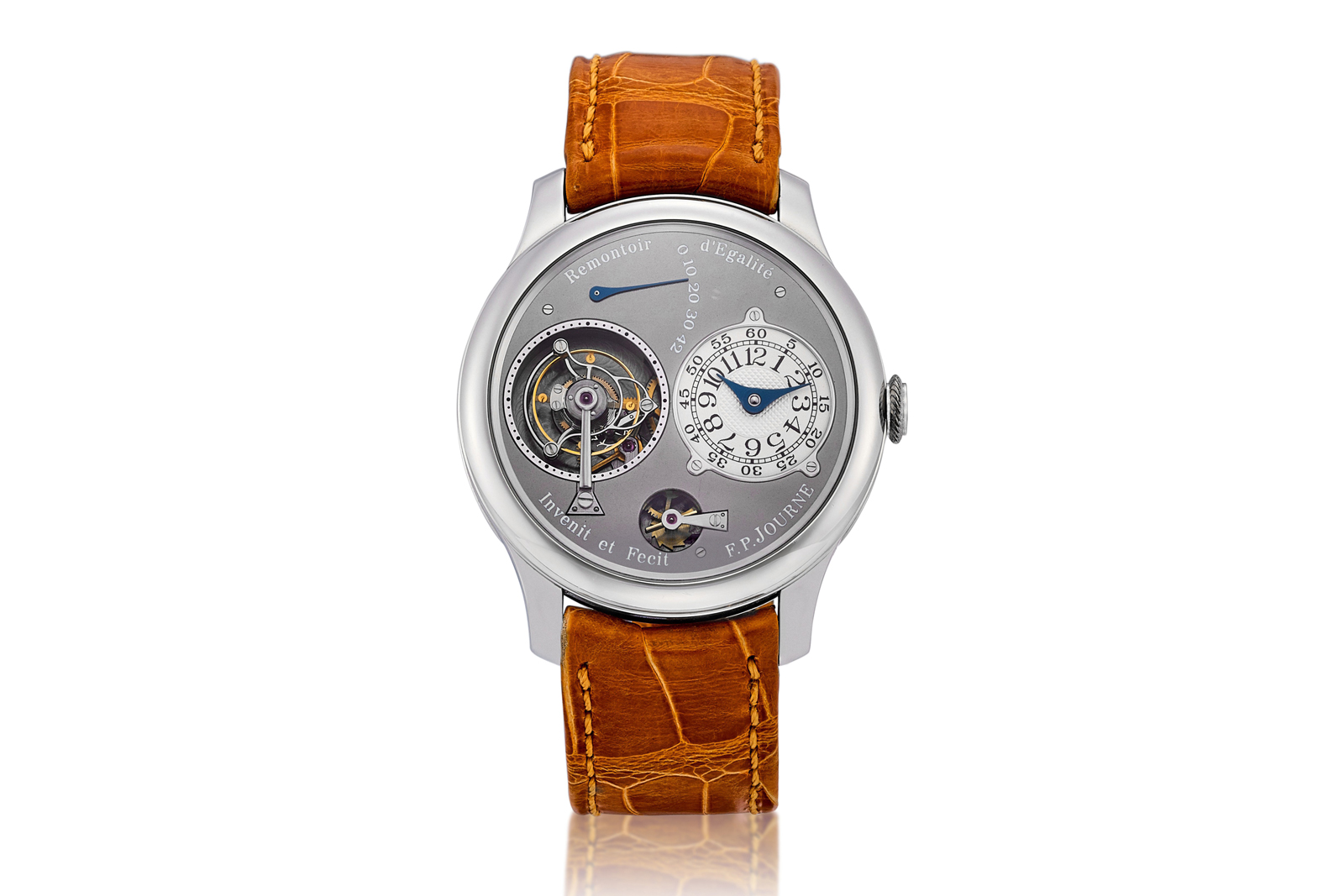
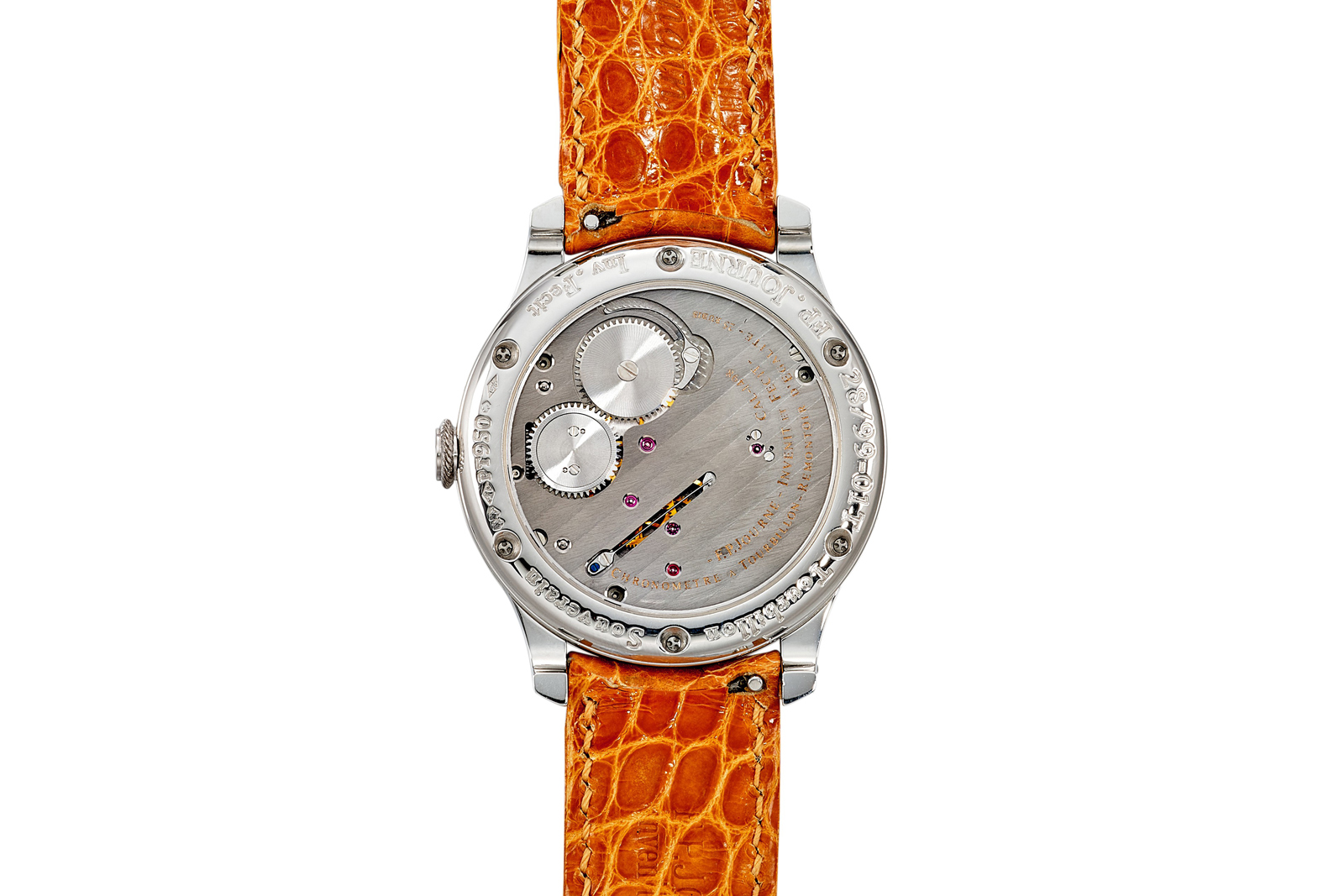
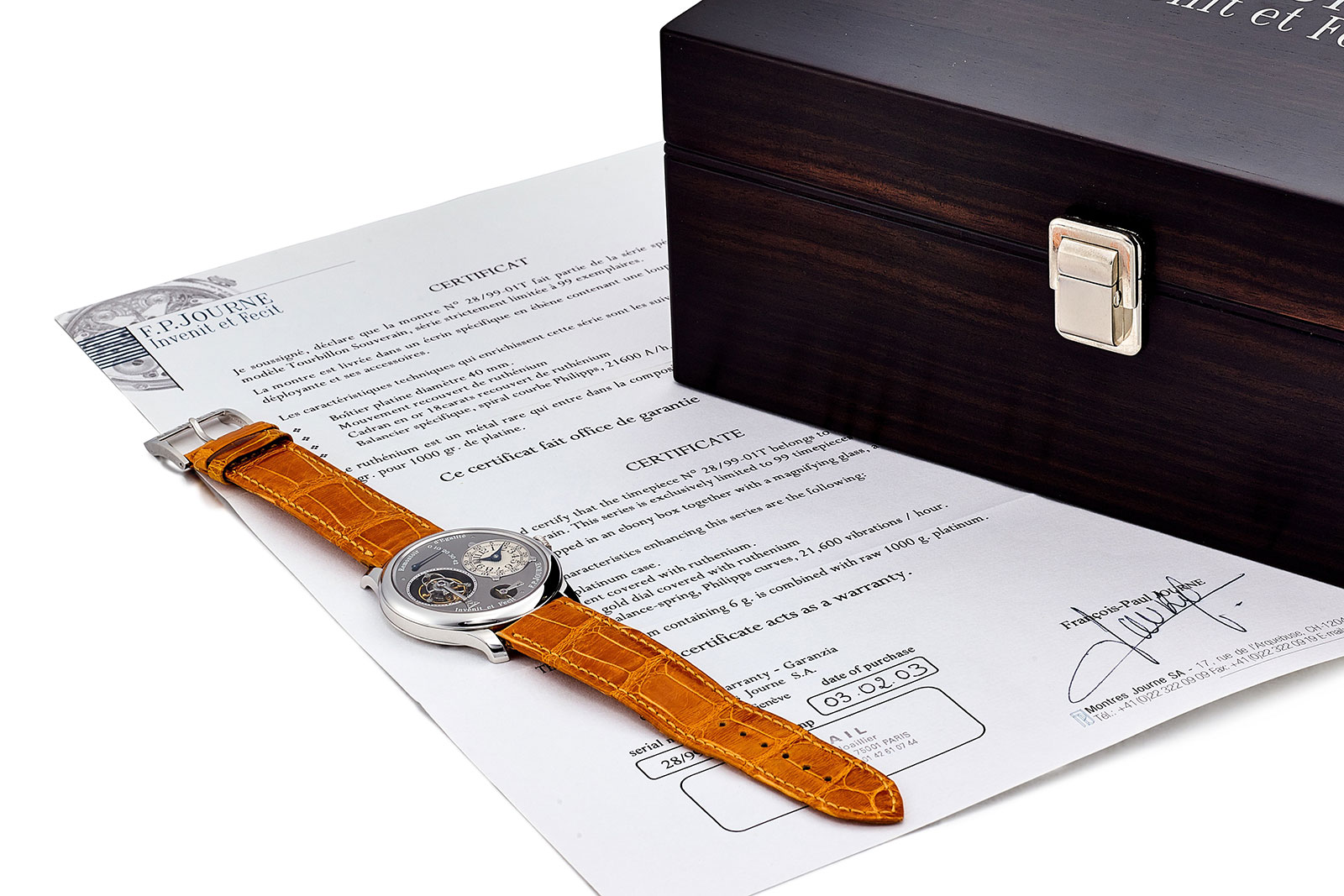
The present example is numbered 28 out of the 99-piece edition. All the goodies are included, including the original certificate, box, and accessories like a folding clasp and loupe.
It has an estimate of HK$2.8-4.0 million, or US$360,000-515,000. Full lot details here.
Lot 2095: Tourbillon Souverain “Souscription”
No doubt the top lot of the F.P. Journe selection, the Tourbillon Souverain “Souscription” was the model that got the F.P. Journe brand off the ground.
The story behind it is well known: Mr Journe unveiled the watch at the Basel Fair in 1999 and crowdfunded his brand with the Souscription tourbillon. He sold the 20 watches to collectors who paid upfront – they “subscribed” to the watch – utilising the capital to kickstart serial production.
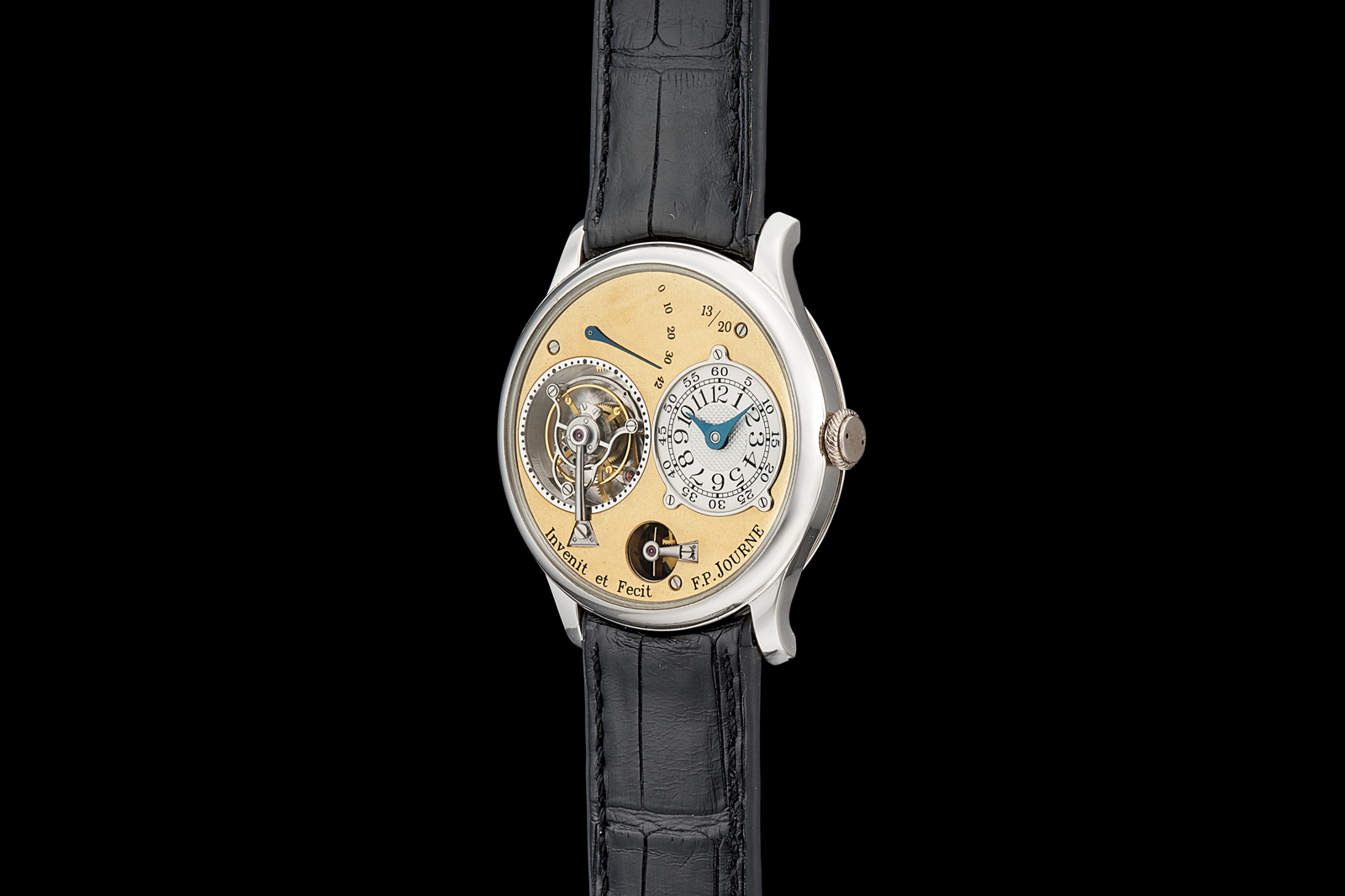
The present example is numbered “13/20”
Beyond the historically significance, early F.P. Journe tourbillons have quirks that make each example distinctive, something that no doubt appeals to diehard fans. That stems from the fact that Mr Journe made most of these watches himself resulting in inconsistencies that ironically enhanced their charm.
The dials in particular bear faint scratches under their clear lacquer that are visible at certain angles, a telltale sign of hand finishing. And the clear lacquer gives the dials a notably shiny finish that catches the light beautifully. The dial finish is impossible to discern from the photos, though it should be apparent in real life.
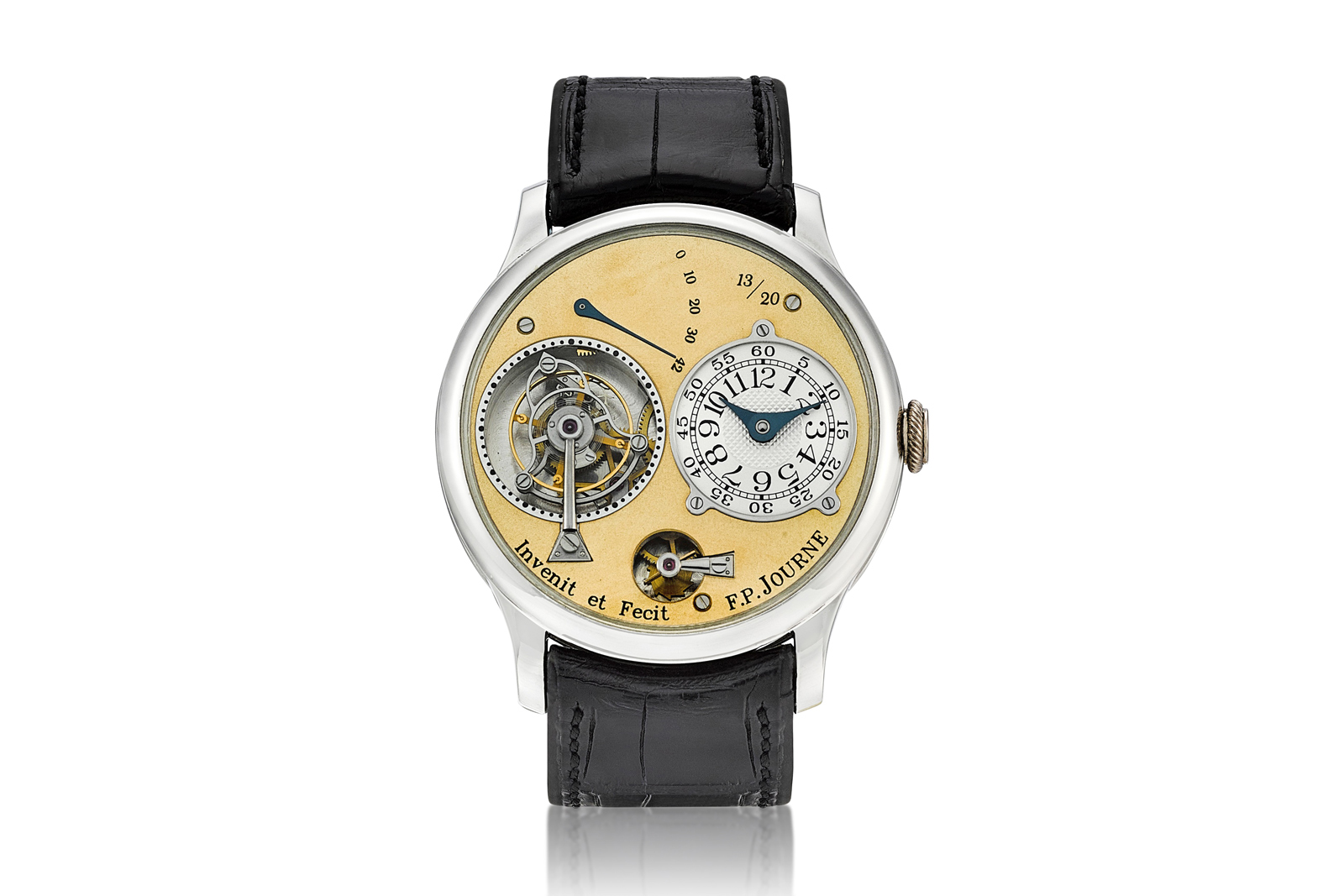
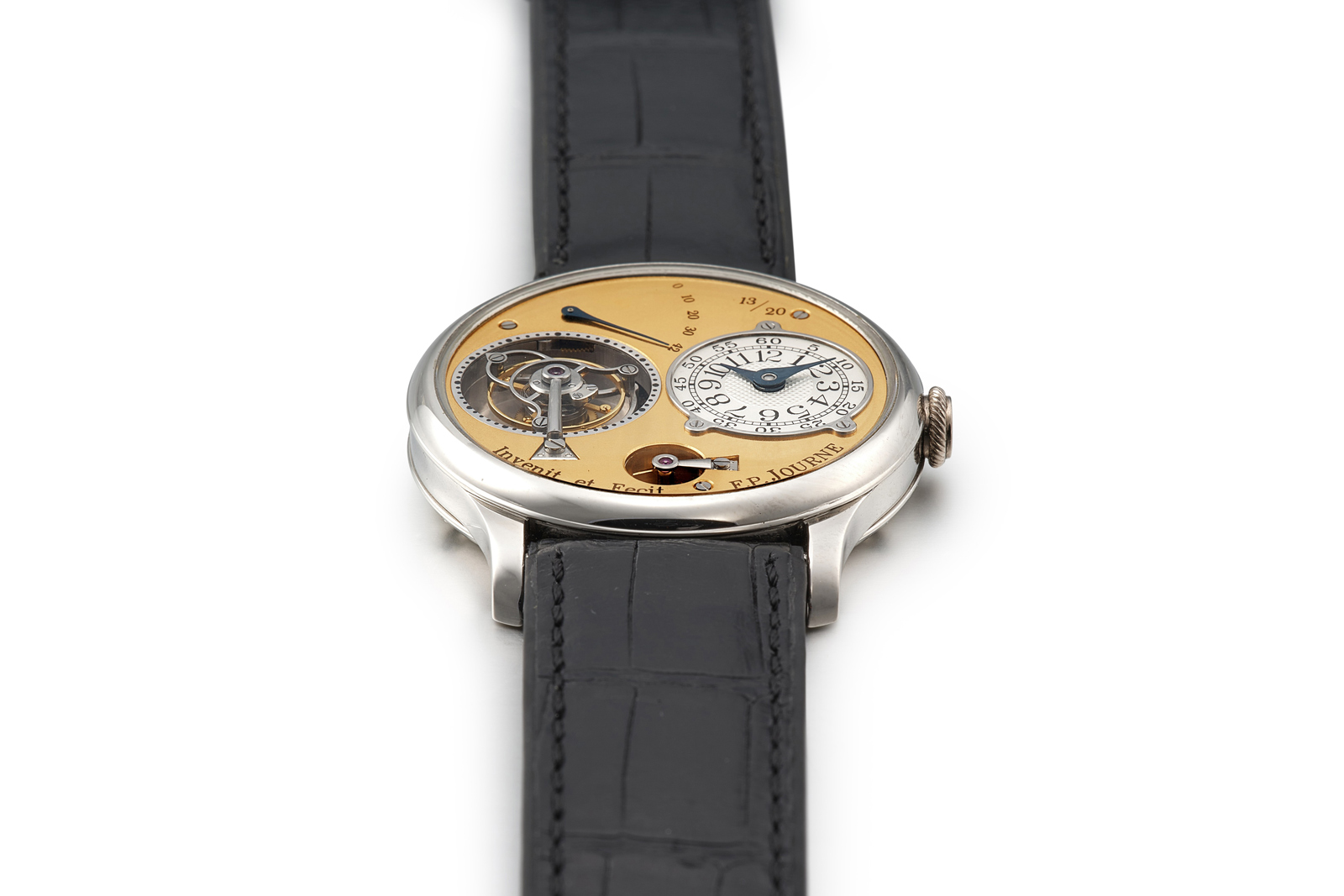
Another feature unique to the Souscription and early examples of the tourbillon is rounded remontoir cock at six o’clock, which was replaced by a flat cock in the third generation of tourbillon
The Souscription tourbillon was also the start of rhodium-plated brass movements for F.P. Journe, as Mr Journe decided to do away with his original idea of a solid-gold movement for cost reasons. However, he preserved the aesthetic of the gold movement with the gold dial that was actually the base plate in the prototype first seen at the Basel Fair in 1991.
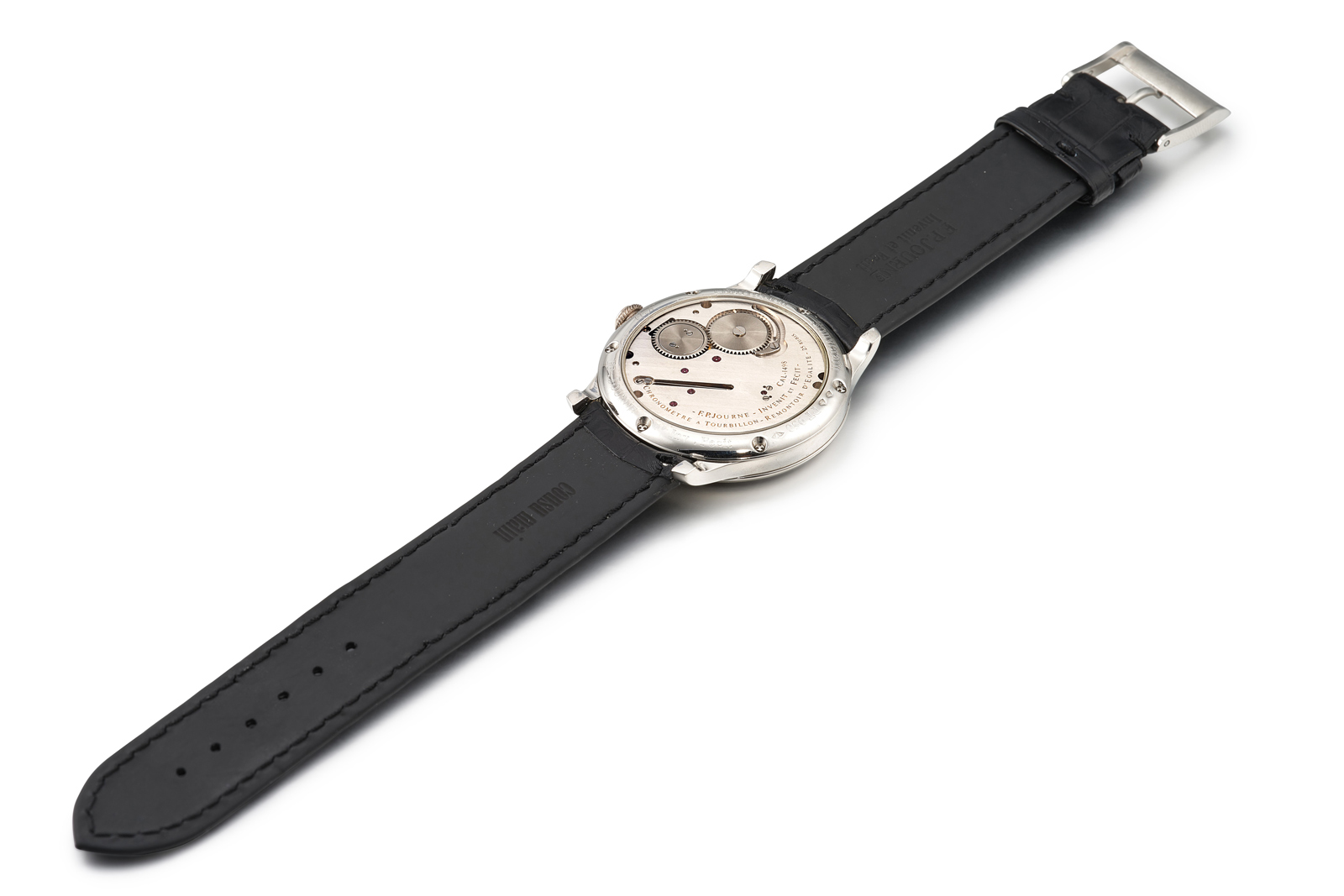
The movement with its rhodiumed full plate on the back
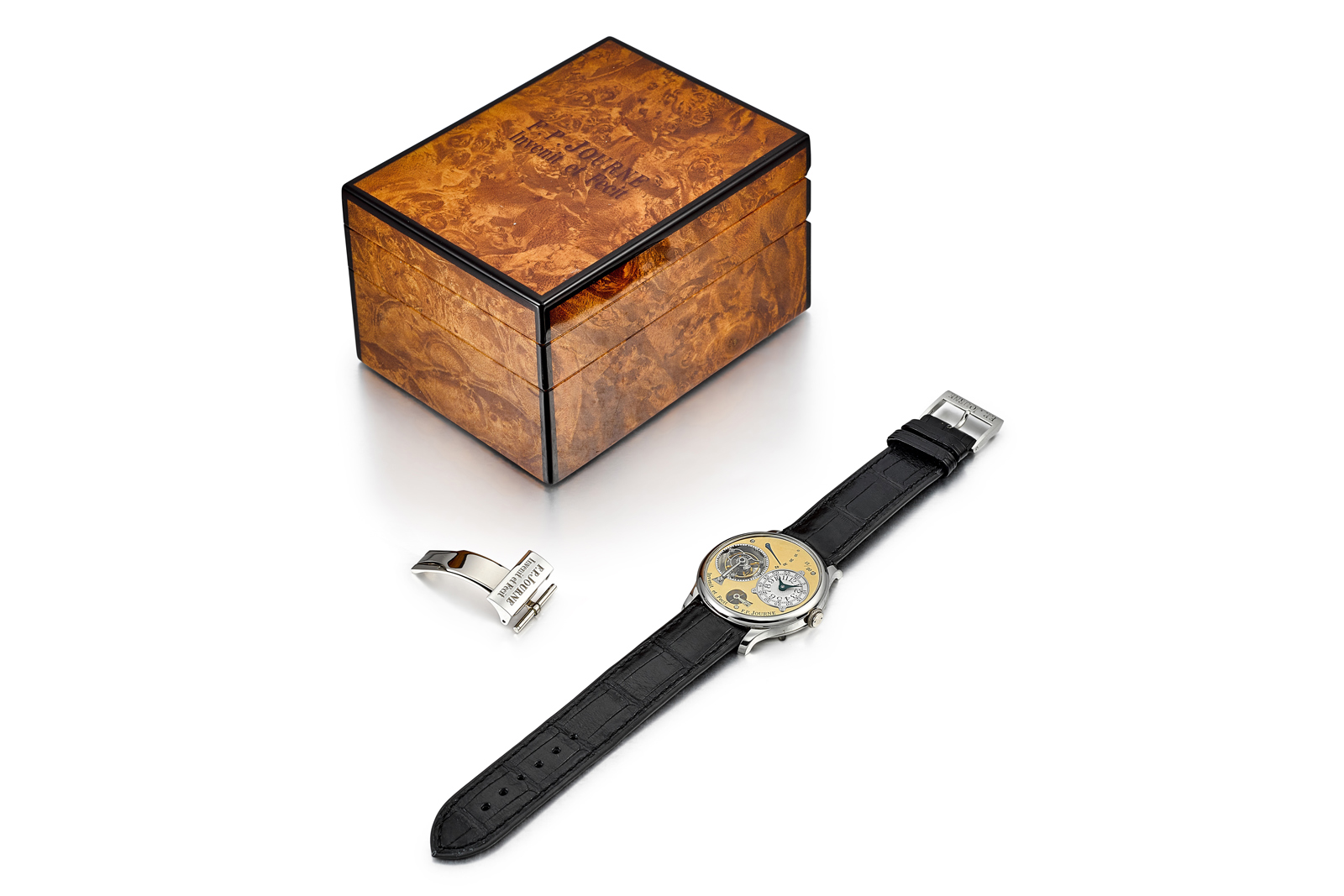
The watch includes an additional folding clasp and the original compact box in burl wood veneer
While only a handful of the Souscription watches were made, their ever-increasing values in the last four years have meant that a good proportion of them has changed hands, with another scheduled to be sold at Phillips in Geneva come November. The extreme desirability of the watch makes it likely that there’s enough demand to ensure both examples sell handsomely. This has an estimate of HK$6.5-9.5 million, or around US$835,000-1.22 million. Full lot details here.
Preview and Auction
The preview exhibition is open daily from October 7-12 at the New Wing of the Hong Kong Convention & Exhibition Centre (HKCEC).
The auction starts at 2:00 pm (GMT+8) on October 13, 2021 taking place at Sotheby’s offices in Pacific Place.
5/F, One Pacific Place, 88 Queensway
Admiralty, Hong Kong
China
For the full catalogue, as well as registration and online bidding, visit Sothebys.com.
This was brought to you in collaboration with Sotheby’s.
Back to top.
